The European end of the world, called Finistere and located in the west of France, plunges into the Atlantic through the coast of the peninsula.
Its territory covers more than three thousand kilometers of the coastline. The relief is diverse, and nature includes a fairly mild climate, but with regular severe ocean winds. Since ancient times, an amazing people have lived here, who are the descendants of the ancient Celtic civilization - the Bretons. To all lovers of French culture and solo travel it is recommended to visit Brittany, also called Armorica or the country by the sea, to see firsthand the prehistoric monuments or to relax on the coast, away from everyday routine.
This region belongs to the possessions of France since time immemorial. Today, this province is rightfully considered the most developed of all the administrative units of the country and consists of four independent departments:
IL-E-VILLEEN with the center in the city of Rennes;
FINISTER - the capital is Quimper;
COTE D'ARMOR - center in the small town of Saint-Brieuc;
MORBIAN with its capital in Vannes.
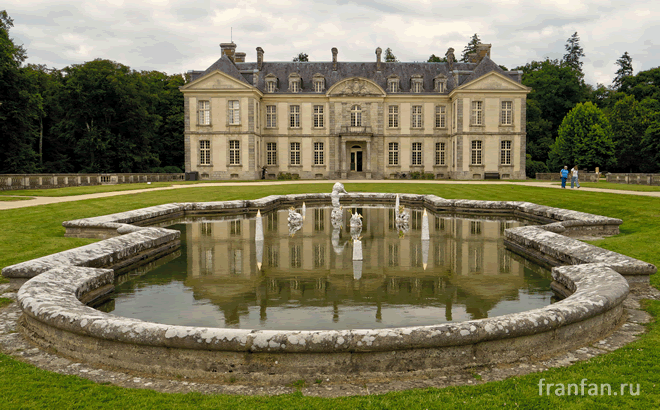
Domaine de Kerguéhennec / Morbihan, Bretagne, France
The central city of the entire region with its own flag, dating back to 1532, is urban settlement Rennes. You can get here by high-speed train from Paris in just a couple of hours. The main cities of the province are considered to be: Ore, Dinard, Vannes, Lorient, Dinant, Saint-Malo, Quimper, Brest.
Brittany has always attracted a huge number of tourists and vacationers, including the native French, thanks to cultural heritage and geographic location. The main factor of the region's attractiveness is the variety of services and offers for travelers: walking in natural areas with a large number of routes, fishing, beach vacation, thalassotherapy, surfing and sea cruises To exotic islands on comfortable yachts. In addition, you can rent a bike or scooter and go along the wild shores on an independent excursion, devoting your time to exploring the famous Castles of the Middle Ages or more ancient buildings related to the megalith and concealing a huge number of unsolved mysteries: cromlechs, menhirs, dolmens and others.
From the point of view of gourmets, Brittany attracts attention with the fresh seafood for which the local port settlements are famous. More details about gastronomic delights will be described below.
There are many places to visit in France, but Brittany has a treasure trove interesting stories and places. Further we will talk about the main attractions, important nuances that arise during the trip and the main aspects of the hospitable region, including the places of recreation and the cuisine of the province.
Brittany weather conditions
The difference between Brittany and other administrative units of France is the mild climate, which excludes hot and sultry summers and frosty winters, thanks to the influence of the Atlantic. The spring period begins quite early and gradually turns into the swimming season until the middle of the first summer month. The main celebrity of the province is considered to be the wind. It provides a surfer's paradise and allows a huge number of wind farms to appear every year, which are scattered throughout the entire peninsula. The local microclimate determines the weather throughout the vast area of the region. For example, most precipitation falls in Brest.Brittany natural treasures
A separate area for which hundreds of thousands of travelers and tourists spend their time and money to visit this unforgettable corner is the emerald coast of Cancale. A raging wave crashing against a lighthouse on the shore, rocky granite shores with their own thousand-year history, a flaming sunset and a sandy beach exposed at low tide are the main attractions of the area. If in Provence the coast is called the Cote d'Azur, then in Brittany the territory from Cancale to Cap-Frèl bears the name Emerald. Deeper one hundred miles in the coast of the province, you can find yourself in the fairy forest of Brosseliande (modern Pampon), which gave rise to the legend of King Arthur, who dominated the knights of the round table. In the Middle Ages, the local forest plantations were famous for their density and impassability, so overland communication between cities in this area was not as common as regular sea voyages along the coast from one port town to another and Great Britain. This opportunity greatly influenced the economic relations between Brittany and Foggy Albion.
National character of the Bretons
Modern residents of the region rightfully consider themselves descendants ancient people- the Celts who fled the Saxon invasion in the fifth century AD from the islands of Britain. It was they who named the future territory of France Brittany, and the people who live here permanently have been waging a diplomatic war for independence for five hundred years. The culture of the Bretons is very similar to the Scottish, Irish and Welsh, expressed in national flavor and mentality, language, music and oral traditions. Books are devoted to the character of these people, and their main qualities are hospitality, patriotism, sincerity, fortitude, severity, independence and straightforwardness. The fate of this long-suffering, but happy and not surrendering people is colored by the struggle for independence, first with the Romans and Vikings, and later with the British and French.
Brittany has been officially part of France since 1532, but the inhabitants of the province still express their desire for independence. You can understand these people, because the power of the regional economy and other additional characteristics of an administrative unit are quite comparable to a small European state such as Belgium. Especially the province is ahead of others French regions to develop modern the latest technologies and student performance in school.
Brittany culture
The symbol of the three elements, revered by all Bretons, is the triskel. The distinctive culture of the peninsula reigns even in the smallest detail. It is enough to get acquainted with the holy springs and wells, villages with exquisite houses and thatched roofs. Visit local pubs and drink national cider there, move away from tourist routes to hear the local speech, more reminiscent of British than traditional French, and toss firewood in the fireplace at the simple request of a local, rooted in the Celtic tradition. Regular folklore festivals will surprise even the most sophisticated traveler with the attitude of Bretons of any age.
The culture local residents lately it has become really in demand again. The main evidence of the new flourishing of Celtic traditions is the popularity of various events designed to show Brittany from a new side: the international festival in the city of Lorient, the festival of the old plow, the annual festival in the urban village of Cornuay, and many others.
In order to feel that very Celtic atmosphere, every traveler and tourist simply needs to visit the famous "night party", which is regularly held in the region. Here anyone will be taught the traditional dance of the province. A short lesson will not cause difficulty even for a person who does not give in to the art of choreography, but it will give an unforgettable pleasure from learning and communicating with Bretons. Summer season may include several parties of this type at once, held daily in the area up to thirty kilometers, and the schedule of each event can be found in any information travel company.
But the true soul of a native Breton can be comprehended only after close communication with a local resident or the whole family, because the main feature of their kind and sincere character over the centuries is hospitality.
Brittany cuisine
Arriving on a visit to a Breton, you need to be ready for a hearty dinner or lunch. The traditional cuisine of the region does not belong to diet food and was formed by hearty dishes that regularly gave strength to local peasants or sailors plowing the seas. The three main symbols of Brittany's cuisine are buckwheat flour, salted butter and seafood. It is worth dwelling on each of them in more detail here.
Buckwheat flour has spread throughout the province as a cheap alternative to the wheat product. Biscuits are rightfully considered the main dish made from this product. In their appearance, they resemble ordinary pancakes, but unlike such a dish, which is used with a sweet filling, biscuits are served salty. They can be ordered at any "Blinnaya", which are open in almost every city in the region.
Salted oil appeared a long time ago, when, in the absence of refrigerators and other storage places common in Europe, it was customary to add salt to oil, primarily for long journeys by sea. Brittany's pies and pastries contain a huge amount of salted oil, making them a very nutritious but high-calorie food.
The traditional seafood of the peninsula is shells, mussels, lobsters and oysters. They are considered to be among the best on the planet. The demand for food is so great that oyster farms can be seen all over the coast. French province... Some types are usually consumed raw, washed down with white wine and lemon juice. Sometimes oysters are served boiled with a special sour cream sauce. Usually seafood is available in any restaurant or cafe, but exotic lovers can get mussels or oysters themselves after low tide. You just need to arm yourself with special equipment and find out from the local residents the rules for collecting seafood.
The main alcoholic drink in Brittany is cider made from apples. It tastes good, and contains little alcohol.
And for dessert, below will be a list of the most common dishes in the region, which are recommended to be tried without fail:
Pancakes with a twinkle. Served as a dessert. The finished product is poured with rum, and then set on fire and served.
Biscuits. Consist of buckwheat pancake with salted filling. Usually seafood, eggs, vegetables and cheese are used in this capacity.
Kig-a-Fars. Translated as stuffed meat. It is made from several types of meat, to which buckwheat flour contained in a canvas bag is added.
Mussels in sour cream sauce. One word fits this dish - yummy.
Headlight. Sweet pie stuffed with a creamy base.
Quinn-Amann. Buttered pie.
In contact with
The visiting card of Brittany is an amazing coast: mesmerizing ebb and flow, the poetic Coast of Pink Granite, rock cliffs of Cape Freel and Cape Penir, overgrown with gorse and moss, wide beaches with light sand of the Quiberon peninsula, oyster plantations on the Emerald Coast of the Mayan Islands of Cancale and the Islanders of Cancale and the Isle of Cancale.
It is good to start your journey along the coast from the homeland of the French corsairs - the city of Saint-Malo with its impregnable castle and fortress walls, from where a magnificent panorama of the bay, the neighboring resort of Dinard and the beaches opens. The greatest discoverers of the world found peace in the local cathedral, and Chateaubriand is buried on the island of Grand-Baie.
Bretons and their features
Bretons have long been considered the best sailors and fishermen in France, freedom-loving and slightly melancholic. They still treat the past extremely carefully, remember old songs and dances, celebrate ancient holidays and dress up in national costumes these days. They also consider themselves subjects of the Ocean. Here the expression is in use: "Brittany is married to the sea." A number of historians, after research, testified that on the Brittany peninsula, the customs of the inhabitants resemble those of the island peoples. This is probably why the rest of France considers the Bretons to be a little eccentric, and this harsh region is slightly backward from the rest of Europe.
Along the coast there are solid resorts with beaches. If you go inland, you can get to Dinan with its medieval lopsided half-timbered building or the historic city of Lannion, nicknamed the "Happy City". Here, the old quarters and the monastery of the Templars Eglise de Breleven of the 12th century are noteworthy, to the gate of which 142 steep steps lead. Nearby lies in the shadow of a giant viaduct the city of Morlaix, which contains many ancient churches and half-timbered houses, including the mansion of the French Queen Anne of Breton.
Through the rocky "Shores of Legends" Cape Finister, with its many coves and beaches, it is easy to get to one of the most interesting cities Brittany - seaside Brest. It is not only a major port, but also historical Center with a perfectly preserved fortress, built according to Vauban's drawings, the largest drawbridge in Europe Recouvrance, a national botanical garden with a collection of exotic plants and the Montbari Fort of the 17th century.
Further south - the cozy fishing village of Douarnenez and the nearby "Bay of the Dead" with a hundred shipwrecks here. And also the ancient Quimper with 73 half-timbered houses on the rue Quereon, the faience museum and the 80-meter high cathedral in Brittany.
But the most amazing place the region is considered the village of Karnak with three thousand prehistoric megaliths, menhirs and dolmens - the largest cluster in the world. From here you can go through the impenetrable Broceliande forest, where, according to legend, Merlin conjured and druid priests gathered, to the capital of Brittany - the city of Rennes with its palaces, towers and cozy restaurants serving delicious Breton buckwheat pancakes-biscuits.
Rennes is just a stone's throw from the fortified towns that once defended Brittany's borders from France. For example, Vitre, with its Disney castle, complemented by a drawbridge with a moat and winding medieval quarters, or Fougeres, with 13 towers and an unusual fortress in the Nanson Valley.
Thalassotherapy in Brittany
In 1899, the ship's doctor Louis-Eugene Bagot of Brittany established the first thalassotherapy center in Europe in Roscoff. This was facilitated only by the proximity of the sea, but also unique climate region that is located between the English Channel and the Atlantic. As for the seawater, off the Breton coast, it is extremely rich in minerals and trace elements that are important in thalassotherapy.
The traditions of thalassotherapy in Brittany took shape gradually. Today there are 13 thalasso centers in the region offering their services. Among the most famous are the sea baths in Saint-Malo and the thalassotherapy center in Roscoff.
Mother Poulard biscuits
The most delicious, tender and crumbly Breton biscuits are made in Brittany by the Biscuiterie La Mere Poulard factory with a rich history and production secrets. She appeared in Brittany in 1852 through the efforts of Annette Poulard, a talented pastry chef, who for her kind disposition, efforts and invention of more than 700 original culinary recipes and earned the nickname "Mother Poulard". Since then, shortbread cakes, biscuits and biscuits "from Mother Poulard" have become a real culinary legend in the region. Currently, there are more than 4 thousand Biscuiterie La Mere Poulard branded stores throughout France, and not far from the Mont Saint-Michel abbey there is an old factory where cookies can be purchased completely fresh, as they say, “hot, hot”.
Peninsula in the northwest of France. Brittany's climate is mild sea, in winter the temperature almost never drops below zero, and in summer, even if the rest of France suffers from unbearable heat, a fresh sea breeze blows here. Brittany is distinguished by rugged rocky shores, around which are scattered many islands, inside the peninsula - hills and forests. Anyone who comes to the Breton coast for the first time is amazed by the ebb and flow of the Atlantic Ocean - here their difference is the second highest in the world.
Brittany history
Brittany has many historical monuments... Nowhere else in the world is there such an accumulation of burial mounds, dolmens (stone tables), menhirs (vertical stones) and cromlechs (stones standing in a circle). Unfortunately, we know little about the peoples who raised them, and about their purpose, which only adds to the mystery of this mysterious country. In the 5th century BC, the Celts settled on the peninsula. It was they who named this region Armor - a country by the sea. From 50 BC Brittany becomes a Roman province for almost 5 centuries. Brittany acquired its current name when, in the 5th century A.D. island relatives - the Celts - began to arrive on the peninsula. Displaced by the warlike Germanic tribes from the British Isles, their inhabitants began to settle across the desert Armorican peninsula, giving it their name - Little Britain or Brittany. The current inhabitants of Brittany consider themselves to be the descendants of the Breton Celts. The Breton language is close to the language of the people of Wales and Cornwall. Celtic music, which is growing in interest from year to year as the popularity of the Celtic Festival in Lorien is judged, also has common roots in Brittany, Ireland, Scotland, Cornwall and Wales. From the 9th to the 16th century, Brittany was independent, but in 1491, the last Duchess of Brittany, Anne, married the French king Charles VIII.
Brittany cuisine
Crabs, lobsters, oysters, lobsters, shrimps and other seafood on ice, garnished with seaweed, are the pride of the Breton table. Surrounded by the harsh seascapes and the smell of the sea, his gifts take on a special taste. Another typical Breton dish is crepes. Buckwheat pancakes are served with salty fillings (ham, cheese and whatever comes to mind of the chef), and wheat pancakes - with jams, fruits, aromatic liqueurs or ice cream. Brittany's national drink is cider. Low-alcohol apple (although there are other varieties) drink can be sweet or dry and has its own bouquet and color range depending on the year and place of production. Brittany is also famous for sweets - far Breton, prune pie, and a variety of dry biscuits are famous throughout France.
Each stretch of Brittany's rugged coastline has its own romantic, self-explanatory name. Emerald Coast, Wild Coast, Megalith Coast, Pink Granite Coast and Legends Coast speak of the sea, rocks and ancient inhabitants of Brittany.
Saint-Malo
Anyone who comes to Brittany should definitely visit Saint-Malo. The name of the city comes from the name of the English monk Malo, who preached Christianity in this region in the 6th century. AD Today it is a thriving port city. There are several docks in Saint-Malo for commercial, tourist boats and ferries.
The historical reputation of the city cannot be called impeccable. Saint-Malo was the home of the corsairs, as well as the center of the slave trade. The ramparts that surround the "old city" offer wonderful views of the city itself, the sea, and the picturesque urban surroundings. While in Saint-Malo, you should go to the castle-museum, go on an excursion to the Aquarium.
Excursion boats depart from Saint-Malo to the English Channel: Jersey and Guerness. Despite the fact that the islands legally belong to the UK (Russian citizens need a visa), they are located closer to the French coast. Also from Saint-Malo you can visit the medieval city of Dinan.
Dinan
Dinan was the seat of the Dukes of Brittany. Dinan is a walled city. This is how he appears on the Bayeux tapestry. The city stands 75 meters above the Rance River, surrounded by a wall that is considered the highest fortified wall in the region.
In Dinan you will have the opportunity to see many monuments of architecture and history. Among them are the Basilica of the Savior (SaintSauveur, XII century) and the Church of Saint-Malo (XV century), which have been constantly updated and restored since their inception. In this regard, a mixture of styles can be observed in their architecture, reflecting the characteristics of a particular era in which restoration was carried out. The same can be said about the castle, the construction of which began in the 13th century and ended in the 15th century. The castle houses a museum of the history of Dinan from the founding of the city to the present day.
The Port of Dinan is located at the base of the viaduct that connects the banks of the Rance River. Boat trips are available for those wishing to admire the scenery of the Rance area. The local tourism office will offer you a program of thematic tours, and the city hall has lists of exhibitions and festivals.
Dinar
From the middle of the XIX century. Dinard, a small fishing town, was an administratively dependent unit belonging to the neighboring parish of Saint Enogat. Despite the fact that the port of Dinara is small, fishing has always been an important part of the life of this town. From here, fishermen set out on long voyages, fishing in the waters around Newfoundland. Meanwhile, the climate, nature, magnificent beaches began to attract here noble and wealthy people from all over Europe. Dinard's life changed in 1850 with the arrival of the wealthy English Faber family; then several more families from America arrived in the city. From that moment on, the golden times came for Dinar. This period lasted until the outbreak of the First World War.
Today Dinard is one of the most famous international tourist centers... Improvements in the service sector, expanding technical capabilities contribute to the fact that the city develops, but at the same time does not lose its charm.
In addition to the flavor of the city itself, you will have the opportunity to appreciate the beauty of parks and gardens, the splendor of the villas and the diversity of cultural life.
Rennes
Most Big City region, the capital of Brittany since the 16th century, when, after the annexation of Brittany to France in 1532, the local parliament was moved here from Nantes. In 1720, a fire destroyed most of the wooden houses of that time; therefore, most of the quarters of the city center are characterized by buildings from the 18th century. However, a large number of old half-timbered houses have also survived (the area of rue Saint-Saveur, rue du Chapitre). One of these "half-timbered" streets, rue Saint Michel, is called the "Rue of Thirst" due to the huge number of bars located here.
Among the most interesting sights of Rennes are the Parliament building (1618-1706), where the Supreme Court now sits, the Basilica of the Savior (XVII-XVIII centuries), the City Hall square with the town hall on one side, and the theater building on the other. The city is a member of the Association of Historic Cities of Brittany, which means that the municipality strictly monitors the observance of the rules of restoration and preservation of the unity of the style of the urban ensemble.
Rennes is 2 hours from Paris by TGV train (from Montparnasse station).
Broceliande Forest
One of the most mysterious places in Brittany, abode legendary Merlin, King Arthur and the Fairy Biviana.
Karnak
It is famous all over the world thanks to the unique accumulation of monuments of the megalithic era. Burial mounds and burial mounds of the 2nd-4th millennium BC, about 4000 menhirs - upright standing stones.
Morbihan
Bay in the south of Brittany, which is scattered with many picturesque islands. There are many thalassotherapy centers around the bay. In the center is the well-preserved medieval town of Vannes.
Vannes
The emergence of a settlement on the territory where Vannes is now located dates back to the 1st century. BC NS. In those days this place was called Darioritum. Like most ancient cities, the "old city" is protected by fortress walls. The ramparts have survived to this day, from which a beautiful view of the city opens. In the center of the "old town" there is a cathedral built in the 13th century. Among the many attractions of the old city, the Morbihan Archaeological Museum occupies a special place. Here are exhibits from the early settlements in Brittany, as well as archaeological finds from the megalithic era, found in the territory of Karnak.
A large port city, Vannes is located on the coast of the Gulf of Morbihan. Arriving here, you can just walk around the port, or you can go on one of the many sea excursions. The local tourism office, which is open all year round, offers themed sightseeing tours. There are many castles and nature reserves in the vicinity of Van, where you can have a great time in a relaxed atmosphere.
Van will delight gourmets with a huge selection of restaurants, and shopping lovers - with numerous shops.
Finistere
the westernmost department of Brittany. Here is the port city of Brest, the ancient picturesque town of Quimper and the town of Port Aven, famous for the art school of the same name.
Bel-Ile-en-Mer
The largest, most famous, and perhaps the most beautiful of the islands of Brittany. Its name, which translates as "Beautiful Island", speaks for itself. Belle-Ile inspired many artists, including Matisse and Monet, who created 38 canvases in 3 weeks of his stay here (mainly - landscapes of the town of Aiguilles de Port-Coton).
The island of Belle-Ile, located just 15 kilometers from the Quiberon peninsula, is the pearl of the Iles du Ponant archipelago. The island, where heather and golden gorse grow everywhere, seems to be illuminated by the light of pristine nature, the purity and transparency of the sea that washes its shores. Numerous coves, quiet harbors, grottoes hidden in the rocks keep the secrets of this deserted island. Belle-Ile is a corner at the edge of the earth, stretching 20 kilometers in length and 9 kilometers in width, and offers many opportunities for relaxation and entertainment.
The most convenient way to get to Bel-Ile is from the Quiberon Peninsula. Coming from Rennes, take the road towards Lorient (N24), before Ploermel, take the N166 towards Vannes, then onto the N165 towards Auray, from Ore take 28 km in the direction of Quiberon.
You can leave the car on paid parking Le Semaphore, which is just a 5-minute drive from seaport(there is a free bus several times an hour). The journey time by ferry from Quibron to Bel-Ile is about 40 minutes (it is recommended to book a ferry ticket in advance). You can also take a car to the island, but it costs much more.
Belle-Ile landmarks
Citadel Vauban (La Citadelle Vauban)
An ancient fortress built on the ruins of the Gondi castle. It was fortified by the famous military architect Vauban. It was called the "Shell of the Atlantic", hanging over the capital of the island, Le Palais. Now in the building of the fortress there is a museum, whose exposition tells about the history of the island, and since mid-2006 the first "hotel-museum" in France has opened here, so now anyone can stay in the Citadel.
Le Palais
The capital of the island, this is where ferries from Quibron arrive. A traditional Breton port town located next to the Citadel.
Sauzon (Le Port de Sauzon)
A small port located in the north of the island. The town of fishermen, which reached its heyday by the end of the 19th century. Like Le Palais, it is famous for its abundance of yachts and picturesque surroundings.
Pointe des Poulains
A place of amazing beauty with panoramic views of the surrounding cliffs and the ocean. Weather permitting, you can even see Groix Island, Lorient and the entire Quiberon Bay. Nearby is the estate that belonged to the famous actress Sarah Bernhardt. First arriving on the island in 1894, Bernard fell in love with Belle-Ile at first sight. Since then, for 35 years, the actress has come here every year from Paris in the company of actors and artists. Many celebrities, including King Edward VII of England, have hosted the parties and celebrations hosted here. Currently, part of the former Bernard estate is open to the public.
Temple of Locmaria (Eglise de Locmaria)
The Church of Notre Dame de Locmaria is the oldest church on the island of Belle Ile. Built of stone in the 11th century, it was rebuilt six centuries later.
Beaches
Belle-Ile is famous for its magnificent sandy beaches. Going down to the foot of the cliffs, you can walk along the sand and look at the winding grottoes - the work of the ebb and flow. The whimsical landscapes - piles of stones surrounded by sand and water flowing in or out - are truly mesmerizing. On some beaches of Bel-Ile, you can also see the silent witnesses of the Second World War - German pillboxes carved into the rocks. However, there was no military action on Bel-Ile - the Germans were surrounded from the sea and surrendered without a fight in May 1945.
Other entertainment: Bicycles, walking (tens of kilometers of hiking trails along the coast).
To request or obtain more detailed information, please contact the managers of the MITS company
Page 2 of 2
If, in imitation of the medieval pilgrims, you decide to travel around Brittany, it is better to start from lower Brittany, in particular from Cornuail. Here you will find yourself in the heart of the ancient country of the Celts, which will surely enchant you. The variety of landscapes, dialects and costumes here is truly amazing. The most unusual of all lands is the land of the Bigudans, hidden by a thick veil of fog.
Fig trees grow in gardens separated by stone walls near Penmark Point.
On the coast, from Ile Tudi to Saint Genole,

there are no less than ten small ports where it is worth seeing the return of fishing boats at dusk.
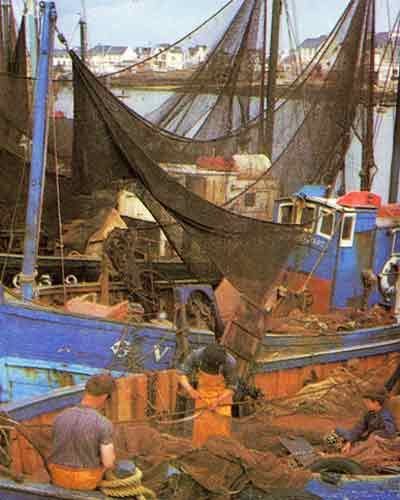
The country of bigudans has its own symbol - a cylindrical female headdress
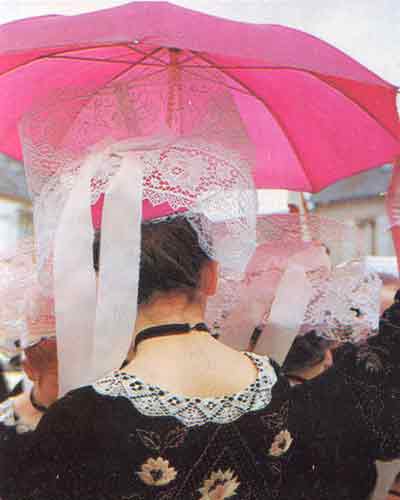
and its capital - Pont-l "Abbe.
There is also a shrine here - Tronoen, the oldest of the Breton roadside crucifixes, towering on a powerful stone plinth over the flat fields near the Gulf of Audierne.
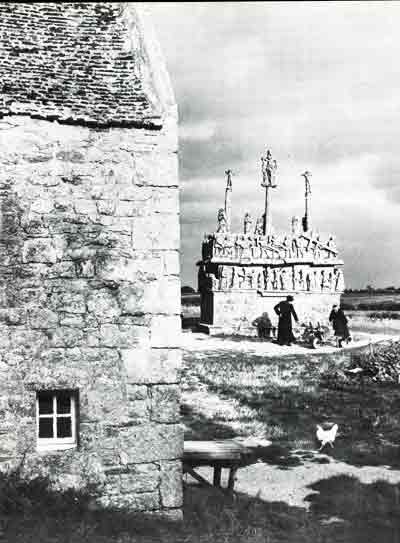
This place has been considered sacred since pre-Christian times, when Aphrodite Anadiomenes was worshiped here. The smooth plinth of Tronoin, made of slabs, is enlivened by the figures of Christ, the saints, the apostles, Mary Magdalene and Pontius Pilate; there are also images of Eden, purgatory and Golgotha.

The Virgin Mary appears in the guise of a young, sensual and tender woman, just released from her burden. " Here, local craftsmen in the most amazing way combine sincerity and courage in their art."- said the writer and essayist Henri Kefelek. Like other Breton crucifixes, Tronoen puzzles researchers. The fact is that there are no very ancient monuments in these places. Tronoen dates back to the 15th century, while other crucifixes date from the Renaissance. These are not monuments of naive folk art, but the works of professional sculptors who worked in workshops, most often belonging to the Naval Department, and they were intended to strengthen the Christian faith in Brittany, which the church, not without reason, considered still too pagan. But the sculpture of the 15th and 16th centuries in Brittany - precisely in Brittany - is distinguished by some wild and gloomy power, and at the same time it is unusually poetic. These are truly folk works. Perhaps the sculptors were able to reflect the collective identity, the ancient images preserved in the memory of the Bretons.
This primitive mysticism, this severity, this Celtic origin in Cornuay can also be felt at Cape Raz and in the Bay of the Dead. They are imbued with both the landscape and the legends, as it were, born of these rocks, these violent waves that rush towards the flat sandy plains of the island of Seine.
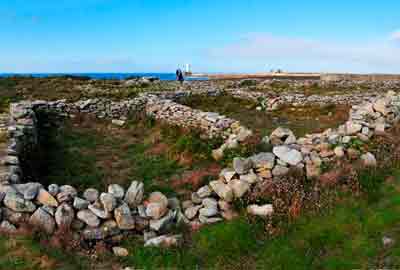
The wind-eaten rocks of the island plunge abruptly into the ocean, crashing down on them with a kind of hellish crash. The coast, the sea and the Seine Island form an indescribably beautiful, wild landscape.
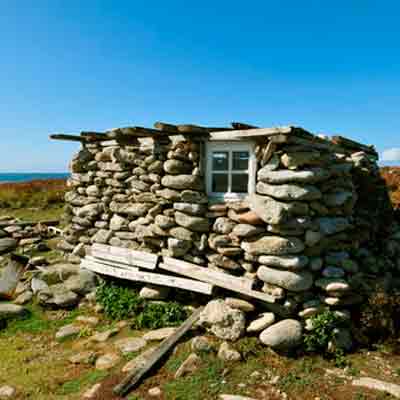
You have to go here alone in winter to reflect on the words of Ernest Renan, who visited these places, in the wilderness, as dreary as it is majestic: “ Man was not created to live here».
Another bay ends with Cape Van, covered with a dense carpet of heather and gorse; it attracts little tourists, although it is distinguished by the same majestic and attractive beauty. Druids lived in this lost corner. They took the most worthy of their departed in boats to the island of Sen, which was also called the Isle of Saints, the Isle of the Old Men, the Isle of Seven Dreams, the Isle of the Nine Priestesses. According to legends, holy virgins lived there, and Mirden - or, in other words, the magician Merlin - was born here.

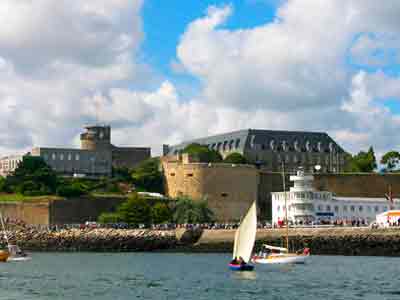
The road leading to Brest passes through famous, most beautiful places: you will see the Tulenge spit, the Chevre peninsula, the port of Camare, where fishing boats are built, you will pass the Morgue and its sea grottoes, Lokronan, where sails were once made (now there is a nature reserve), Saint -Ann-la-Palud, where the most popular holiday in lower Brittany is held - the "procession of pilgrims", Plugastel - a real seaside Arcadia, with fertile lands, orchards and orchards that make up the glory and wealth of this area. Beyond Brest begins Leon, the austere and majestic land of the "abers" - deep bays at the mouths of the rivers, along which the ocean waters penetrate into the depths of the coast. On the deepest of them, the ocean, shimmering with silver water reaches the beaches of the Gulven Bay. There are countless old castles, old churches, old estates, crucifixes and ossuaries - they stretch from Guimillo to Saint-Tegonnec. In the open, always restless sea, the islands of Molen and Uesan are visible - the latter, perhaps, is the ancient Thule. Spit Saint-Mathieu, as it were, marks the real end of the earth. This gloomy place was dubbed "the coast of legends" for the outlines of the rocks and especially for its huge, roughly hewn menhirs. During the Middle Ages, many of them were consecrated.
But in the more cheerful and welcoming Morbihan, the megaliths remained the same as they were created by the ancient cult. Near Karnak, from Kermarjo to Lokmarjaker, two thousand six hundred stones put on the butt were stretched out in ranks, forming an outlandish, some kind of unearthly landscape.
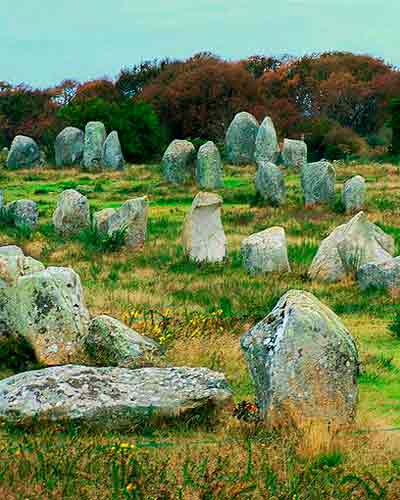
No one knows the true purpose of these stones, but it can be assumed that they have to do with cosmogony. Morbihan, the "little sea", with its capital Van and the town of Sainte-en-d'Auré, where the "great procession of pilgrims" takes place, is also a pleasant place to relax. Quiberon has become a major center of thalassotherapy - treatment sea water... Belle-Ile-en-Mer is growing from year to year,
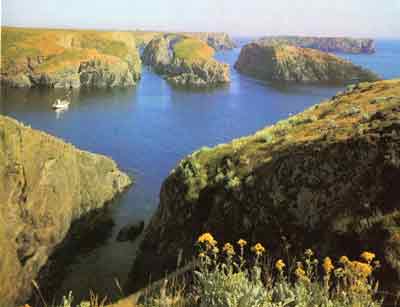
a rocky island with a very mild climate, with welcoming valleys, surrounded by rock debris. According to legend, it was here that fairies, fleeing persecution, threw their wreaths into the sea.
From Tregorroi in the direction of the English Channel and from Morbihan to the Atlantic Ocean stretches the country of Gallo, or, in other words, upper Brittany. It is less original than the lower one, but it also has enough beautiful places, attractive towns, magnificent monuments.
On the coast of the Atlantic Ocean is Nantes, the largest center of Brittany, old City shipowners, owing its prosperity and appearance to the activities of slave traders.
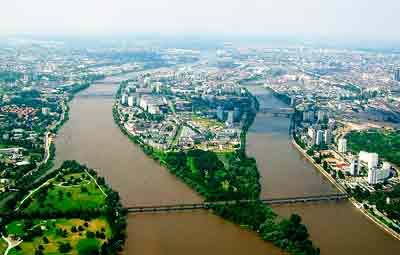
In the XVII and XVIII centuries they have built luxurious mansions for themselves here. Duchess Anne, the last ruler of independent Brittany, was born in Nantes. Her marriage to Charles VIII finally consolidated the duchy's alliance with France. In some films, where the old city was used as a natural setting,
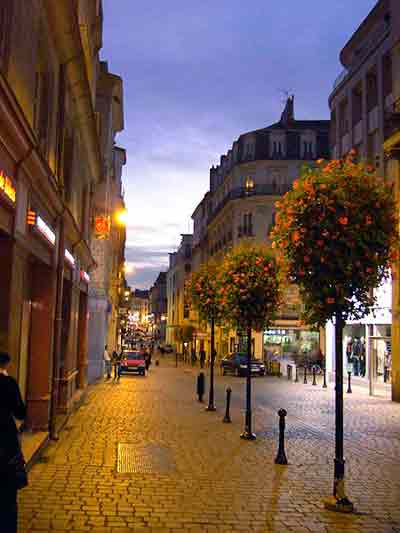
the charm of its streets is perfectly conveyed. On both sides of Nantes stretches the Amur coast, where there are famous resorts with the extensive sandy beaches of La Baule,
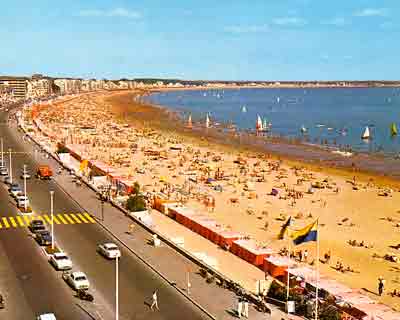
Le Pouligand, Le Croisic, which attract crowds of holidaymakers in the summer.
Salt once played a significant role in the economy of this region. In the middle of the salt marshes rises, always in some strange light, surrounded by fortress walls, the city of Guérande.


The swamps of this flat area, divided into squares and rectangles, seem to be an abstract painting in pearlescent and pastel colors.
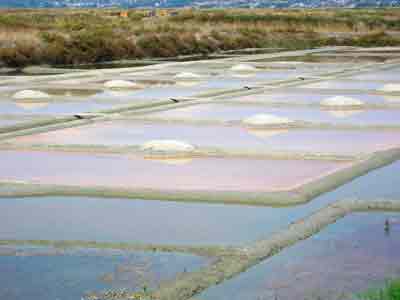
Both at dawn and at dusk, the clouds that came from the sea envelop this area in a sad haze.
Lost among the bogs, Brier - the area where peat was once mined and were engaged in cattle breeding, also evokes sadness. People still use punt boats here.
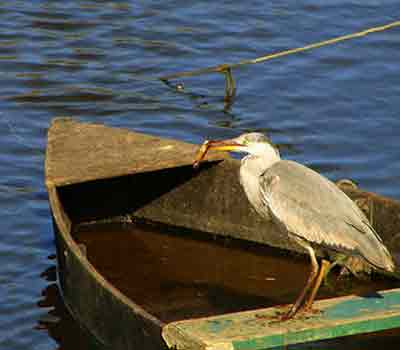
Now this area has become nature reserve with a total area of forty thousand hectares, of which seven thousand are entirely occupied by swamps. The villages are charming with whitewashed houses under thatched roofs.
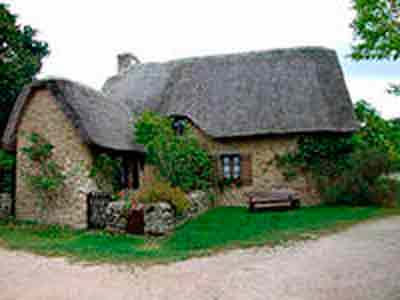
In spring, bright flowers bloom here, reflected in the mirror of stagnant waters. In autumn, when the water and the sky acquire the same, silvery-gray color and become indistinguishable, hunters in their huts made of branches lie in wait for a waterfowl in the fog - ducks and snipe, whose melancholy cries carry the gusts of wind far away.
The inhabitants of this quiet land once had a reputation for being wild and rude. Indeed, at one time it was mainly exiles who had returned from hard labor from Guiana, the only ones who could survive in these sad and abandoned places.
On the road from the English Channel to the Atlantic Ocean is Rennes, one of the most beautiful and today one of the busiest cities in France.
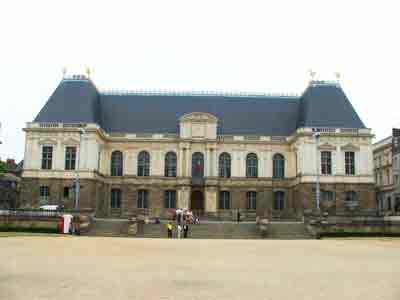
Here was the parliament of Brittany, with which the French kings had endless disagreements. He sat in the current Palais de Justice, a beautiful granite building with grayish reflections, built by Salomon de Bros, the architect of the Luxembourg Palace in Paris, inspired by the local nature, he managed to create a building in a true Breton spirit. As for the town hall, designed by Jacques Gabriel, this building is strictly sustained in the style of the era of Louis XV. Although Rennes is located in the Gallo region, there are also features of Breton Brittany. Not far from here lies the gloomy and lush Pempon Forest, and if you are not afraid to get lost, you can go there in search of the legendary Grail or traces of the legend about it. Pemponsky and Broselian forests bring to mind novels about the knights of the Round Table, about the brave Lancelot and King Arthur, about the wizard Merlin and the sorceress Viviana, about their atrocities and miracles.
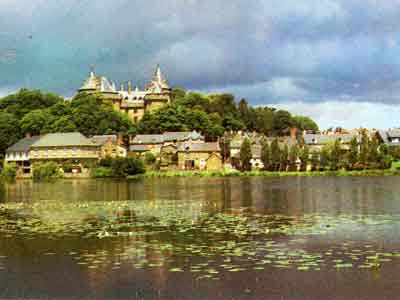
Not far from here is Combourg, the most beautiful feudal castle, the birthplace of Chateaubriand. Nature and architecture gave rich writing for his youthful dreams: a few kilometers from here begins the Brocelian Forest, on the other side you can go to the English Channel, to the Granite Coast with pink rocks eaten by the sea and captivating hidden coves; here, near Trebirdan, in Lille-Grande, was the fiefdom of King Mark, where Tristan and Isolde Blondurai loved each other.
Between Rennes and the English Channel stretch inland lands Arcoa (forest country); there are forests, rivers, and roads hiding in ravines, and lands, now sparkling with gold gorse and gorse, now in the light purple haze of blooming heather.
To the west of the Rane River, from Cape Freiel to Pempol, lies the Bay of Saint-Briec; on the side of the Granite Coast, it adjoins the Tregorroi region - typically Breton, with small sleepy ports at the mouths of the rivers. Pink granite, emerald sea and a very mild climate - the influence of the Gulf Stream - make the island of Brea and the resorts of Peros-Girek, Treberdan, Plumanak, Tregastel attractive for holidaymakers. At the mouth of the Rance is the town of Dinard, where a factory was built, working on the energy of the ebb and flow. Thanks to him, the city has a magnificent artificial bay, which fits well into the rocky spits and sandy bays created by nature. This is a favorite vacation spot for the British. The direct air line allows English tourists to get here quickly and with all the amenities.
On the other side of the bay there are two wonderful beaches- Saint-Servan and Paramet, they are located at the walls of the most famous city of the corsairs - Saint-Malo.
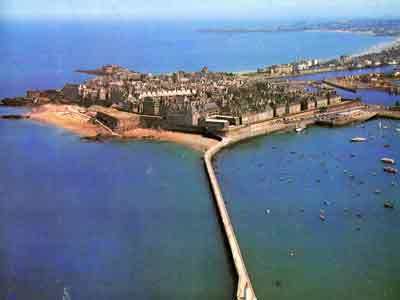
Hidden within its walls, the old “closed city”, despite the bombing and subsequent reconstruction - which, however, was carried out with great care - has retained its charm.
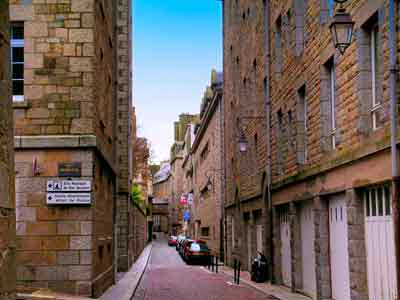
Painted tin signs creak in the wind. In the homes of wealthy shipowners, everything: iron-bound doors, interior decoration - beds, chests-chests, carved sideboards, tables - are made of exotic tree species. There are few such houses left, but still enough to give you, along with the fortifications of the city, an idea of those glorious times of the "great pirate raids" that the inhabitants of Saint-Malo, led by Surcouf, led against the British, Dutch and Spaniards to the considerable benefit of the French king. On the embankments, to the pier, gray-haired men in sea caps come to watch the movement of ships through binoculars; becoming land dwellers, they still dream of the sea.
But change also came to Brittany. Once in this land, alienated from France, poverty reigned. Today, young men and women here, energetic and educated, have firmly decided, just like the youth of Occitania, to stay in their land and contribute to its prosperity. Now, perhaps, a new Brittany is being born, which, having acquired all modern comforts, at the same time will carefully preserve its own face and kind soul.
Thursday, December 17, 2009 15:02 + to the quote pad
Last time you and I, dear readers, saw the sights and unusual places one of the regions of France -.
In this article we will take a trip to another region of France - Brittany .
Ancient castles and powerful fortresses, magnificent Catholic temples, ancient cities, monuments of the megalithic era, forests covered with legends - all this can be seen in Brittany. Brittany is ideal for those tourists looking to discover.
Marked on the map: A - Kankal; B - Saint-Malo; C - Dinan; D - Fort-La-Latte; E - Treguye; F - Plumanac; G - Morlet; H - Roscoff; I - Locronan; J - Kemper; K - Pont L "Abbe; L - Concarneau; M - Karnak; N - Van; O - Josselin; P - Pampon forest (Brosseliand); Q - Rennes; R - Fougeres; S - Vitre.
Brittany - a region in the northwest of France. Capital - Rennes .
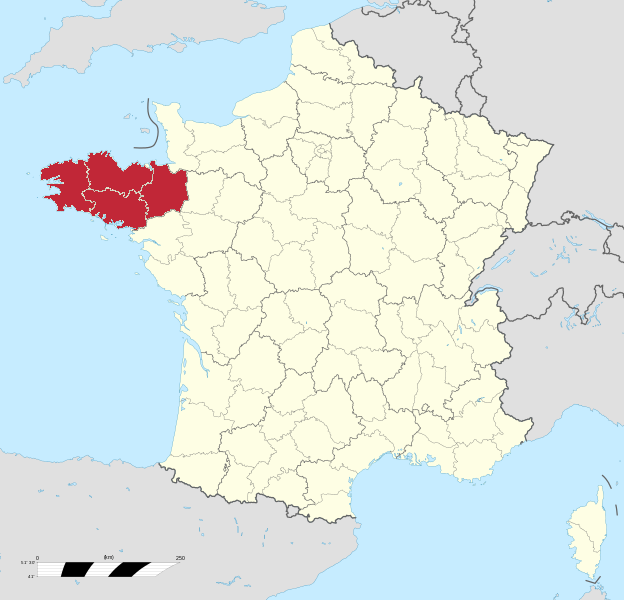
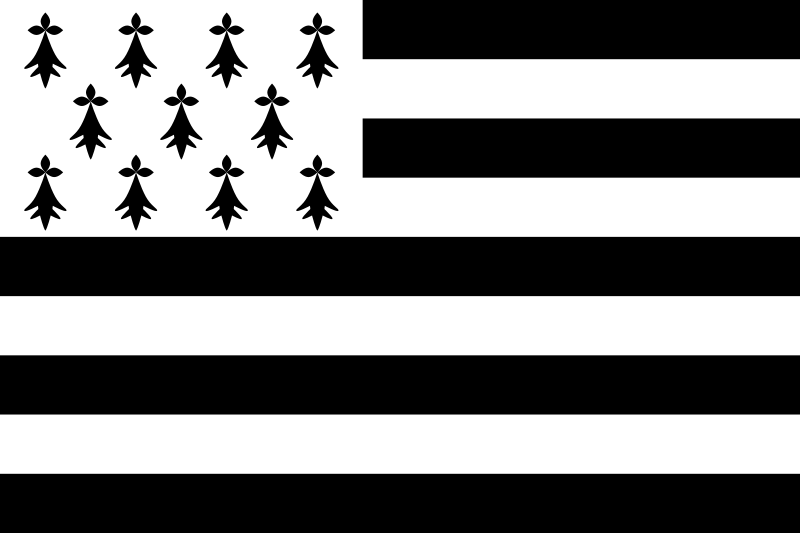
Brittany flag
The original historical region of Brittany was known as part of Gaul called Armorica ("country by the sea"). In the late Roman period, she became the object of mass migration of another Celtic people - the Britons from the British Isles. On the continent, they began to be called Bretons, hence the name "Brittany".
Brittany - peninsula, washed by Atlantic Ocean and the English Channel. Thanks to the influence of the ocean, Brittany has relatively mild winters (27 frosty days a year in Saint-Brieuc) and moderate heat in summer. Spring begins very early, from the beginning of March, but lasts a very long time, as the warming is increasing very slowly. This is the most beautiful time of the year when gorse and gorse are in bloom.
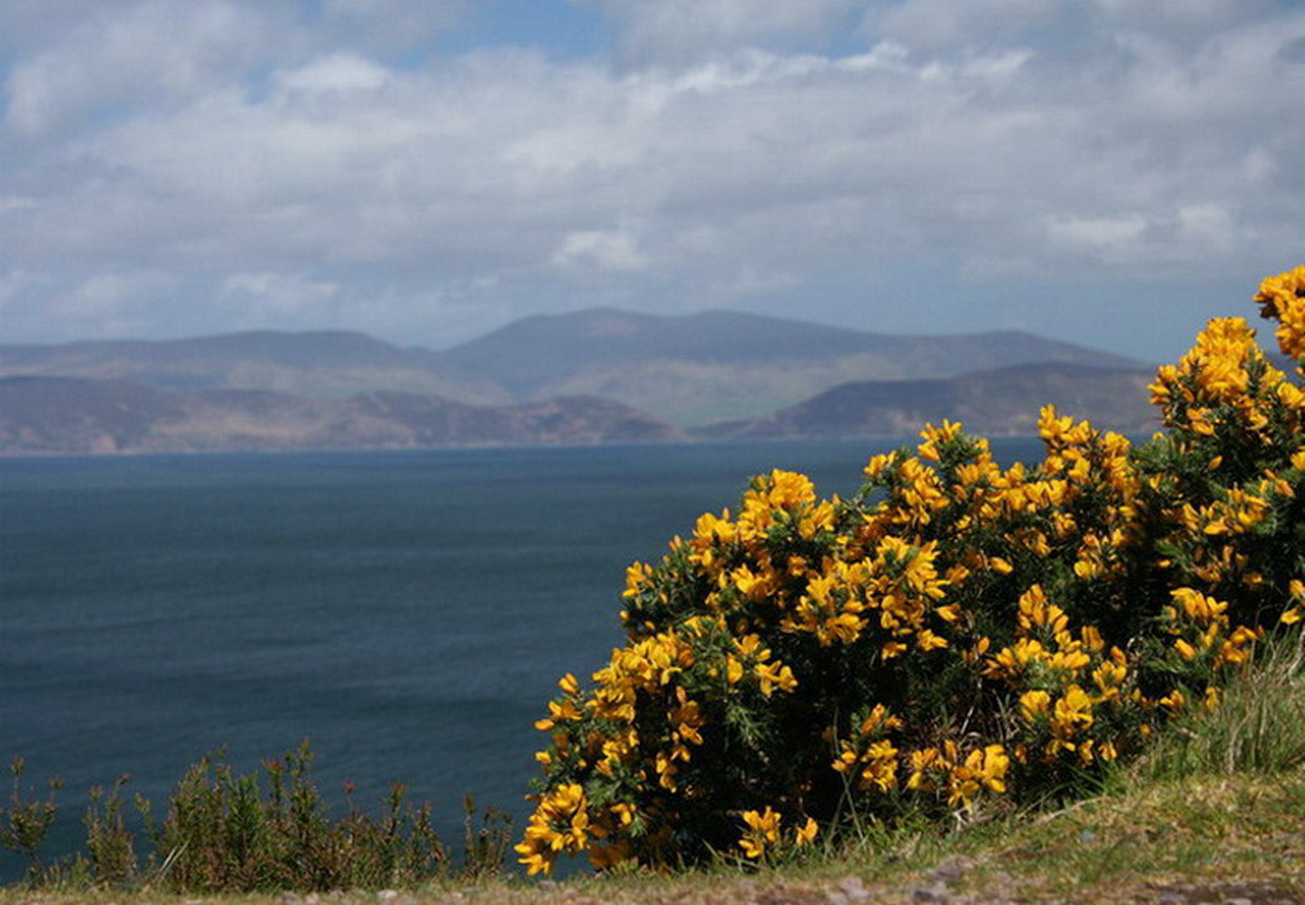
It combines the richness of the historical past, untouched nature, fishermen villages on the coast, as well as prehistoric megaliths - dolmens and menhirs.
The Bretons are considered the best sailors and fishermen in the country. An important trade in Brittany is the cultivation of various oysters and edible shells in artificial pools - "oyster parks". That is why we will begin our journey with you from a small port town Cancale
(Cancale)
which is famous for its oysters. It is located just 15 kilometers east of Saint-Malo. Cancale was founded by a Breton monk, Saint Meen, around 545.
![]()

The place where Cancale is located is called by the French "Emerald Coast" ... The beaches are practically deserted here. In 1545, the Parisian Eshevens signed a contract with Cancale to supply fresh oysters twice a week to the royal table. For this, Kankal was granted the title of a city.
The total area of Kankal's oyster plantations is 400 hectares, so they move around them mainly on tractors.
More information about growing oysters can be found at Ferme Marine is a museum of oysters and shells, where you can watch a themed film, visit the premises of the farm and, of course, taste the freshest oysters. However, in terms of tastings, farms are not inferior to the numerous restaurants located on the embankment in the port.
Cancale is also worth a visit to the original Oyster Museum (Musee de I "HuTtre) and Museum of Wooden Sculptures (Musee de Bois Sculptes ), representing four monumental oak structures.
Nearby on the coast of the Emerald Coast is former town and the port of corsairs Saint-Malo where we are going. The city got its name in honor of Saint Malo. In the 6th century Saint-Malo was the abode of monks. The city itself emerged in the middle of the 12th century. In the Middle Ages, the city was a fortress on an island at the mouth of a river. In 1590-1594. an independent republic existed on the territory of the city. Later Saint-Malo was a refuge for all sorts of pirates, privateers and half-pirates.
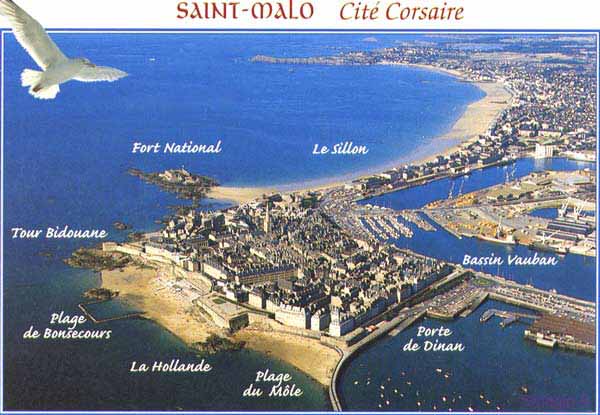
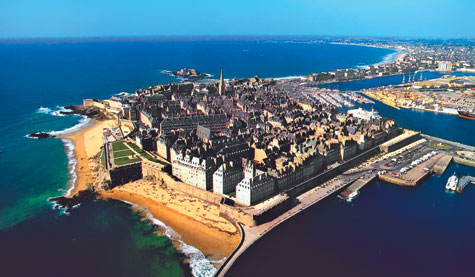
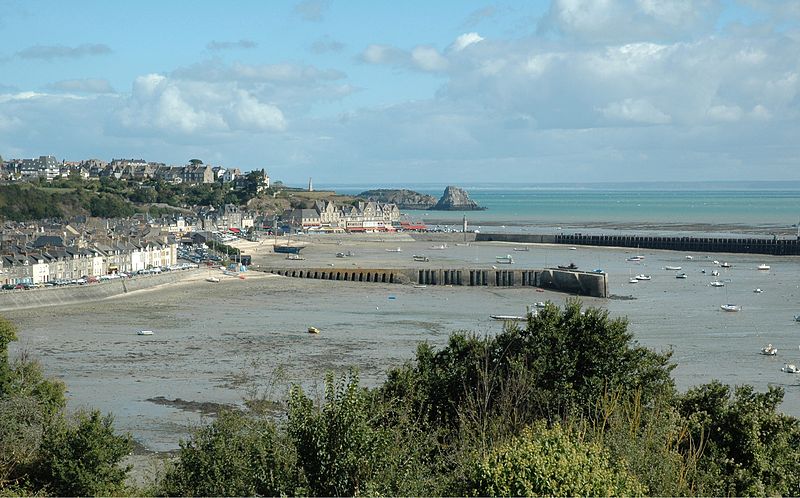
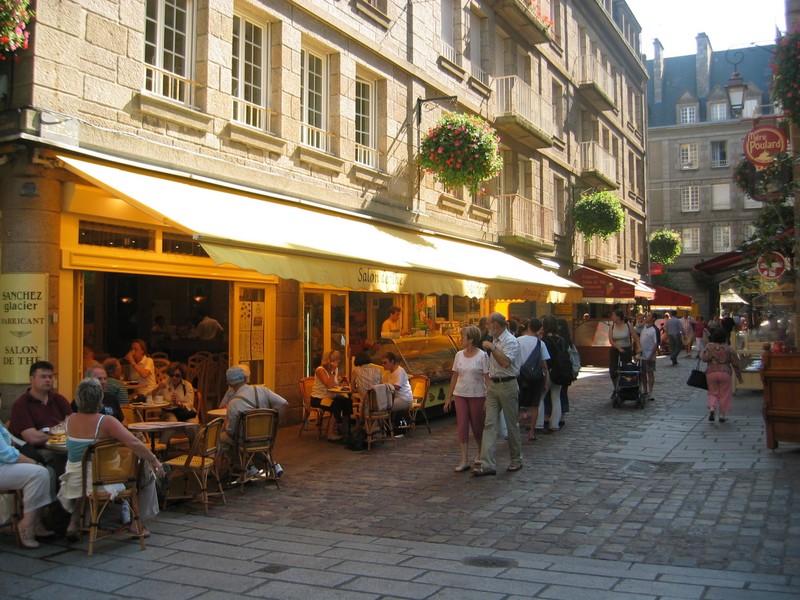
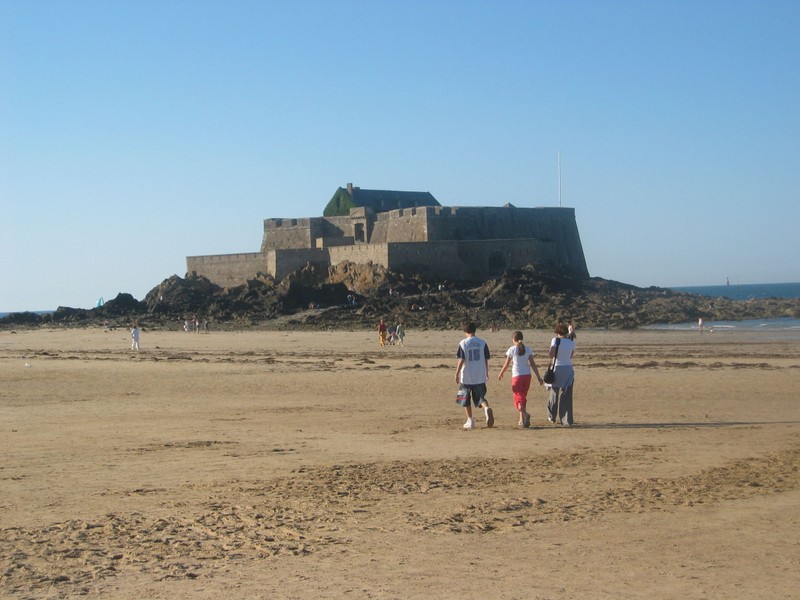
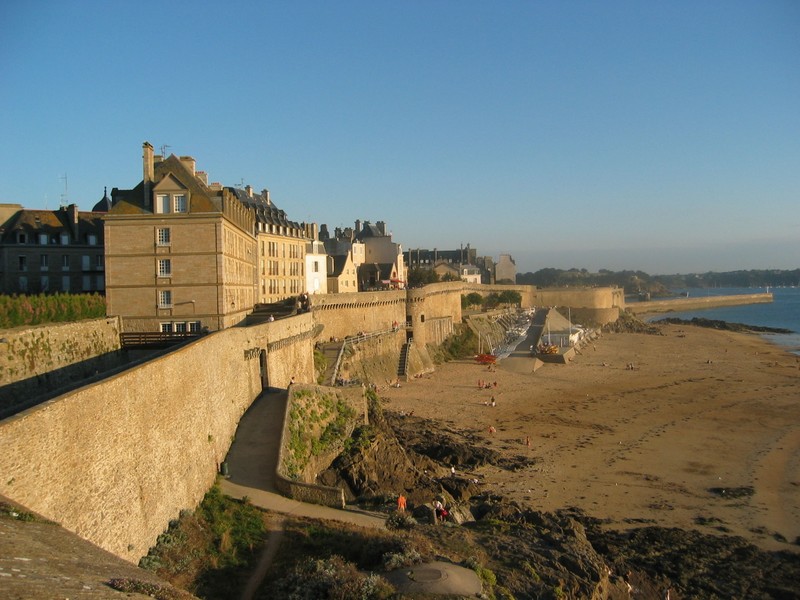
The city is conventionally divided into three districts: the island "inner city" ("Intra Muros") and the mainland, i.e. the suburbs of Saint-Malo - the quarter Saint-Cernand and the eastern suburb of Rotneuf stretched along the mouth of the Ranet River.
V "Intra Muros" located Cathedral of Saint Vincent ... Formally, the cathedral is the seat of the Bishop of Saint-Malo. The cathedral was built in 1146 when Jean de Chatillon by the Bishop of Ale transferred his bishopric to Saint-Malo. The Monastery of Saint-Malo was founded in 1108. Mosaic on the floor illustrates the arrival famous traveler Jacques Cartier, who was born in Saint-Malo, in Canada, here is also his tomb. Established in 1980, the König organ gathers classical music lovers in the summer.

The streets inside the walls are narrow, almost without greenery, the houses are tall, almost identical, made of gray granite.
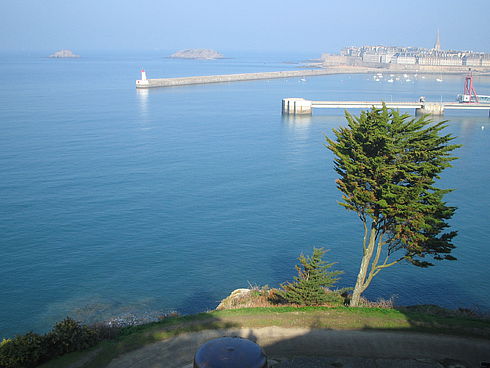
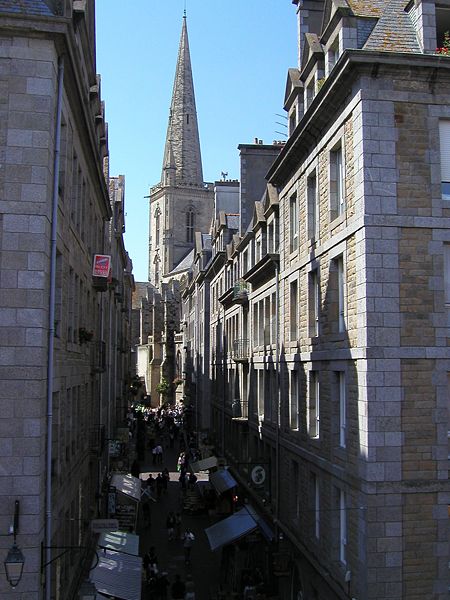
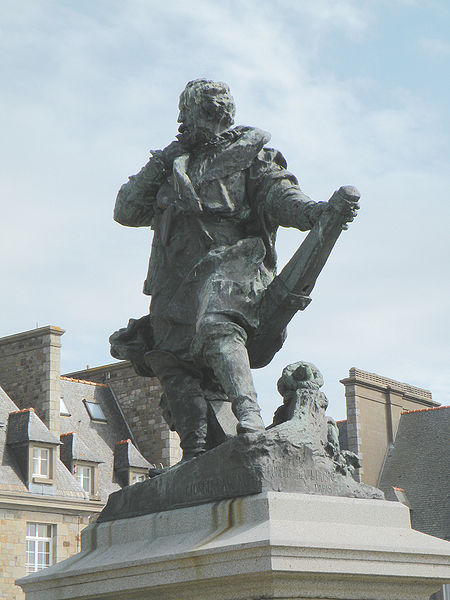
Monument to Jacques Cartier
Castle Saint-Malo was built between the 15th and 18th centuries by the Dukes of Brittany to protect the city from invasions. Saint-Malo, who had ceded the Duke of Brittany to the King of France in 1395, was returned to Jean V in 141. Shortly thereafter, in 1424, the construction of the castle began. The Big Donjon was originally built. In 1475, the Duke of Brittany, François II, began construction of the Main Tower. His daughter Anne, the future Queen of France, completed the Quic-En-Groigne Tower in 1498. A few years later, two other towers were built - "Damskaya" and the "Mills" tower. In the 17th century, the "Galer" bastion, shaped like the bow of a ship, was completed. In 1690, loopholes were made in the castle and artillery pieces were installed. Then two wings were added that served as barracks.
In 1944, during the liberation of the city, the castle was badly damaged, but later completely restored. Today the castle houses Gallery of Kik-an-Gron wax figures , illustrating the thorium of the city, in the keep of the castle housed Municipal Historical Museum (Musee d'Histoire de la Ville et du Pays Malouin) and finally in the main tower of the castle there is Museum of the Malouan Territory (Musee du Pays Malouin).
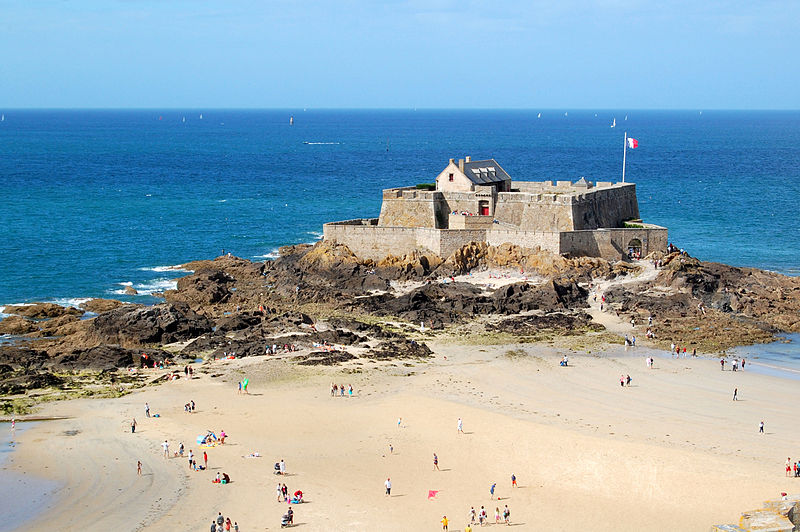
On the Place Vauban in the former fortifications are located aquarium and "exotarium" with a coral department dedicated to the fauna of the French seas and tropical waters.
In the Saint-Servan quarter people lived in Roman times. And even now it is the main residential area of the city. And a business card - Tour Solidor , standing almost on the shore of the strait and as if watching the "Intra Muros". The tower was built between 1369 and 1382 by John V, Duke of Brittany to guard the approaches to Saint-Malo. Over time, the tower lost its strategic importance and turned into a prison. Today the tower houses Museum Cap-Ornier (Musee du Long-Cours Cap-Hornier) dedicated to the sailors who circled Cape Horn. The tower originally belonged to the city of Saint-Servay, which was annexed to Saint-Malo in 1967.
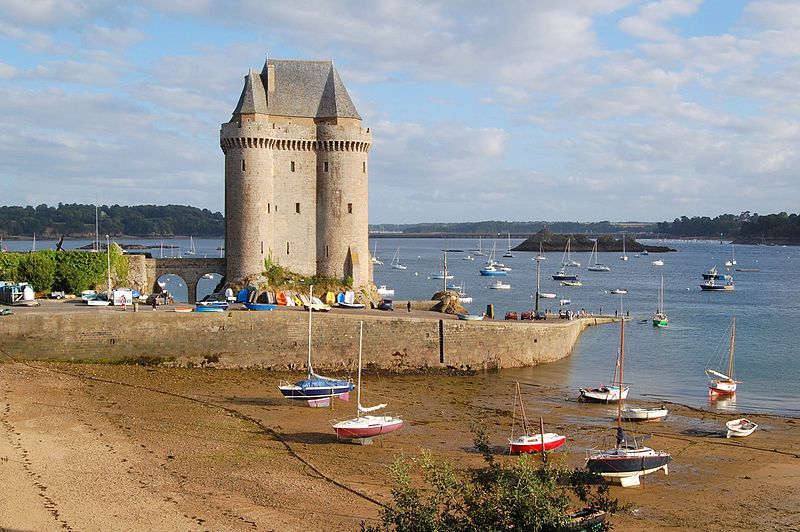
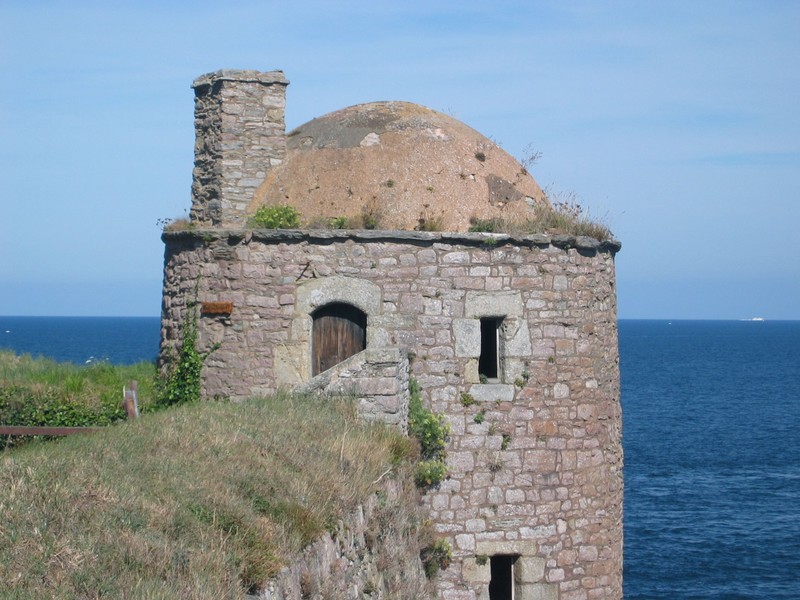
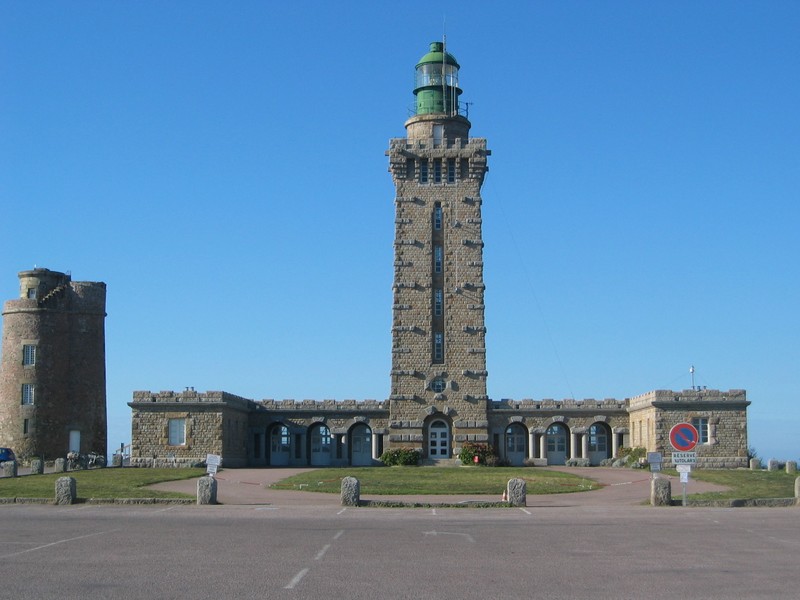
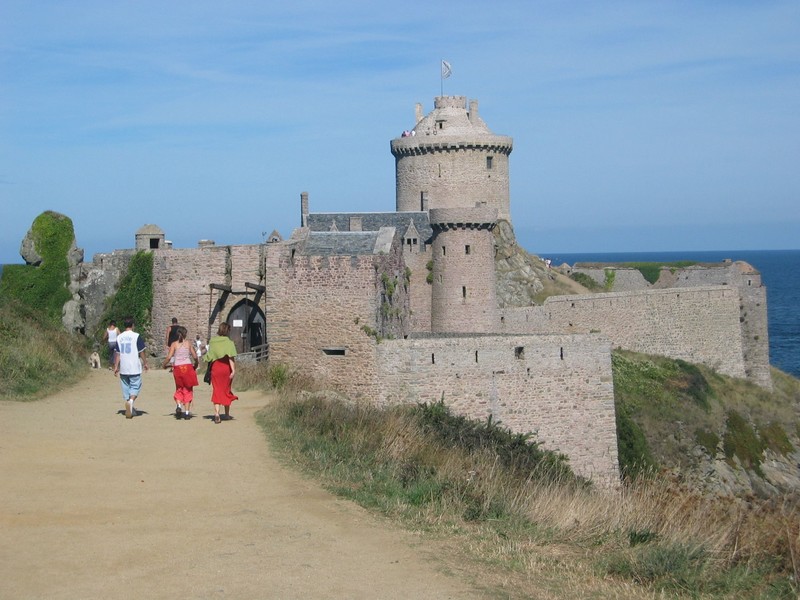
Eastern suburb Rotheneuf known mostly the house of Jacques Cartier ... Jacques Cartier - French navigator who initiated French colonization North America... He was the first European to describe and mapped the Gulf of St. Lawrence and the banks of the St. Lawrence River and the land he called the "Country of Canada". Along with Cabot and Champlain, he is considered one of the main discoverers of Canada.
The Cartier house is squat and long, built of yellow granite, and the doors are deliberately painted in a bright red, a contrasting color. Inside is the Museum of the Corsairs. A curious specimen of sculpture on the rocks is nearby. Obsessed by local abbot Fouret in late XIX century for 25 years carved in the sweat of his brow on granite 300 characters related to the history of the Rotneuf family.


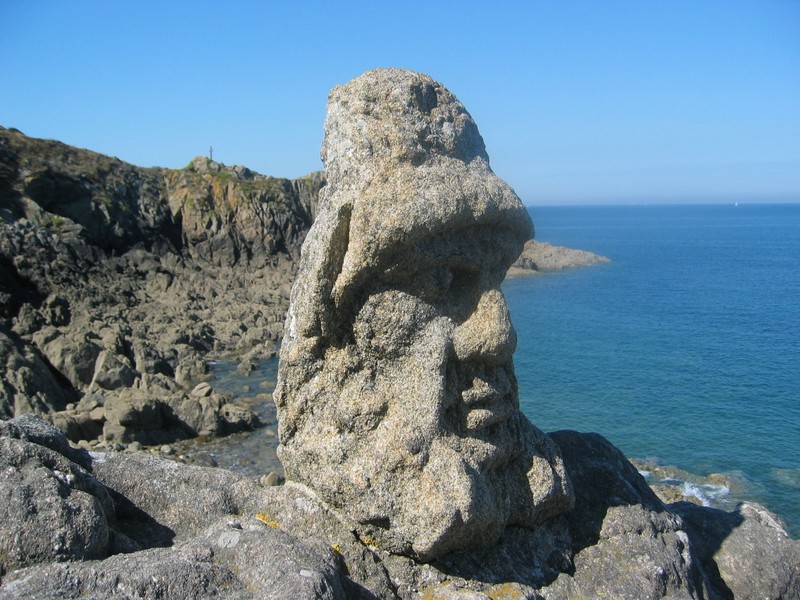
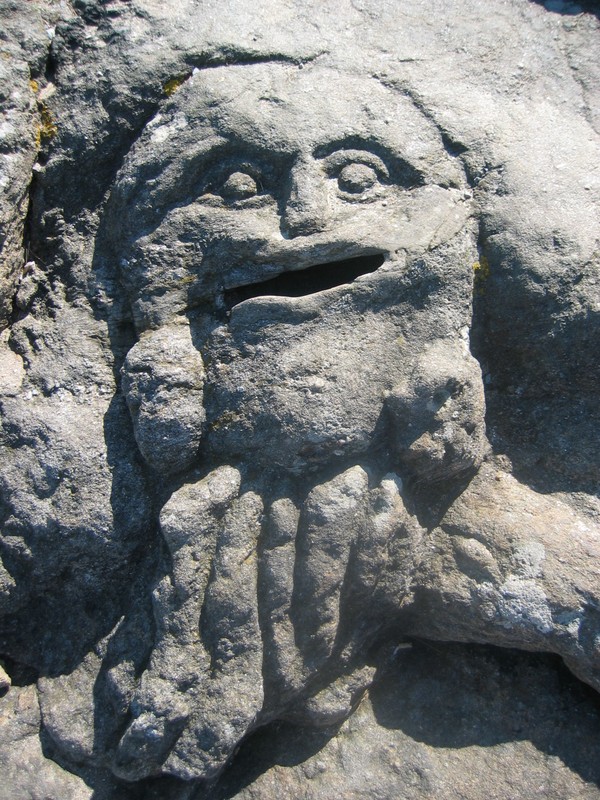
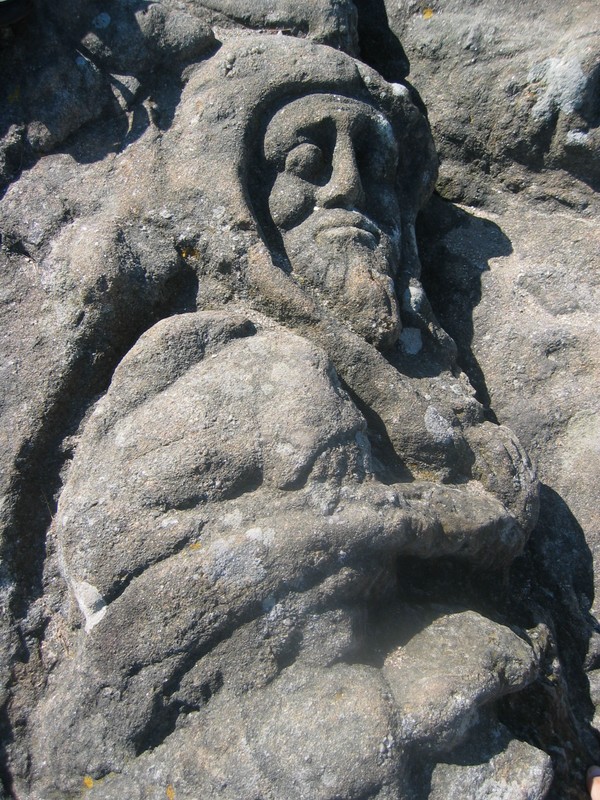
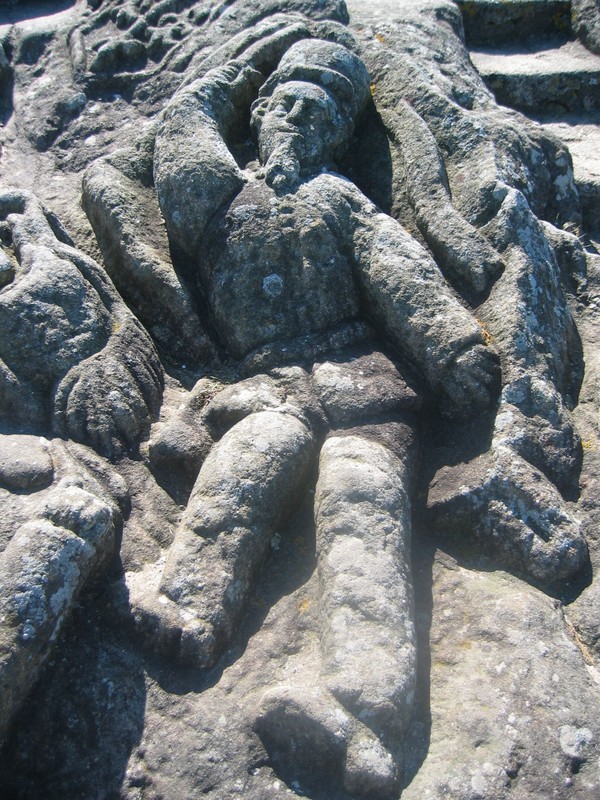
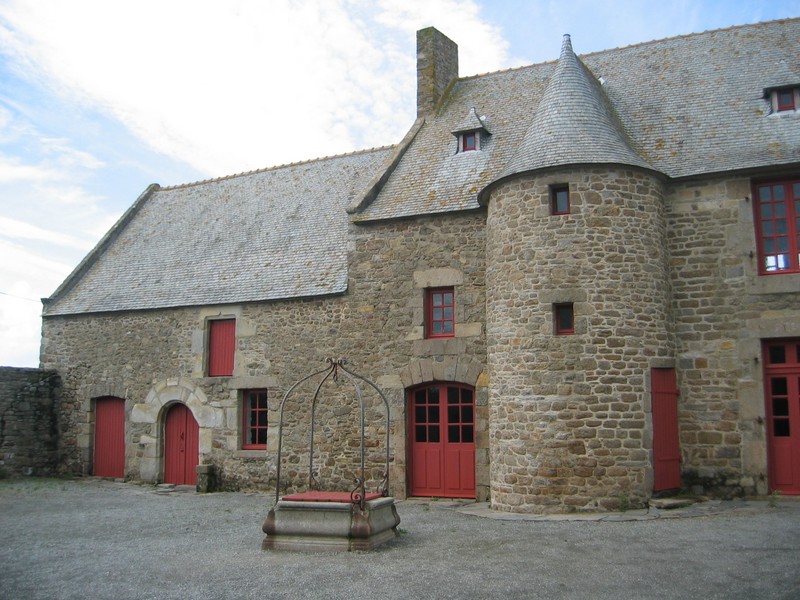
Saint-Malo is the only city from which you can take excursions to British Isle of Jersey
- a very nice corner, loved by tourists. From March to December, several flights depart daily from Saint-Malo to this island.
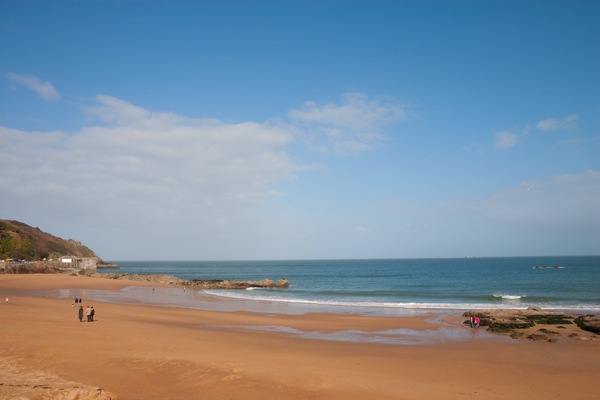
Somewhat in the interior of the province, about 30 km from Saint-Malo is Dinan is a medieval city with beautiful architecture. It is unquestionably one of the most beautiful medieval towns in Brittany. The city lies in the depths of the mouth of the Ranee River, which flows into the sea between Dinard and Saint-Malo on the Emerald Coast.
This town has been known since the 11th century. In 1283, Duke Jean I of Breton erected the city ramparts and towers of Dinan. It lies on the river route to the port of Saint-Malo, so all sea-going goods passed through it. With the advent of railroad in the 19th century, Dinan lost its commercial importance and turned into a resort, especially popular among the British.
Dinan is a city that has almost completely preserved its appearance from the beginning of the 20th century and many medieval monuments. declared a "city of art and history".
Preserved here ring of fortress walls
2600 m long with a donjon, 14 towers and four monumental gates, as well as numerous old houses.
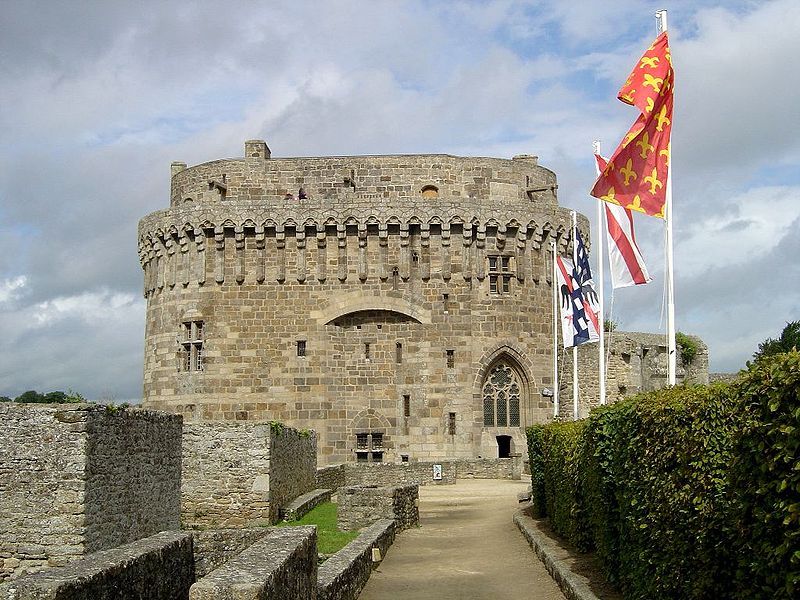
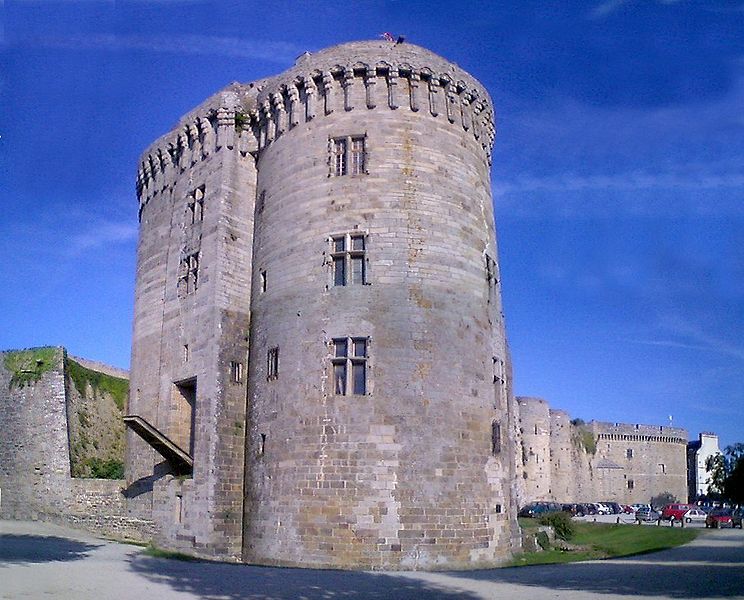

The palace-museum of the 14th century, renovated in the 16th century, contains rich artistic and historical collections. Basilica of the Savior (Basilique Saint-Sauveur) located near English park(Jardin anglais) over the Rane river, was built in the XII century. It combines Romanesque, Gothic, Classical and Baroque styles.

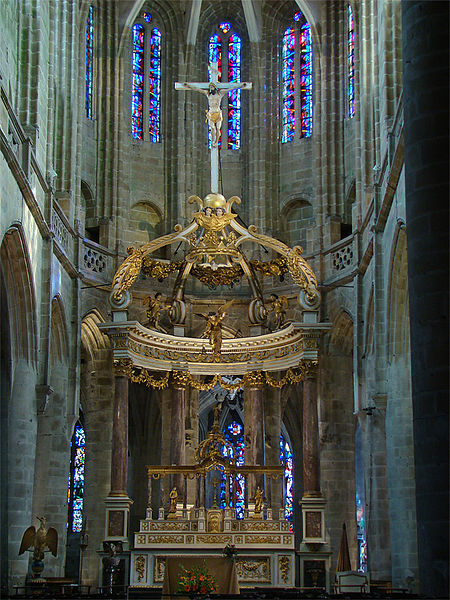
Clock Tower (Tour de I "Horloge) , erected at the end of the 15th century. Duchess Anna, was supplemented by a large bell - a symbol of prosperity and power of the city.
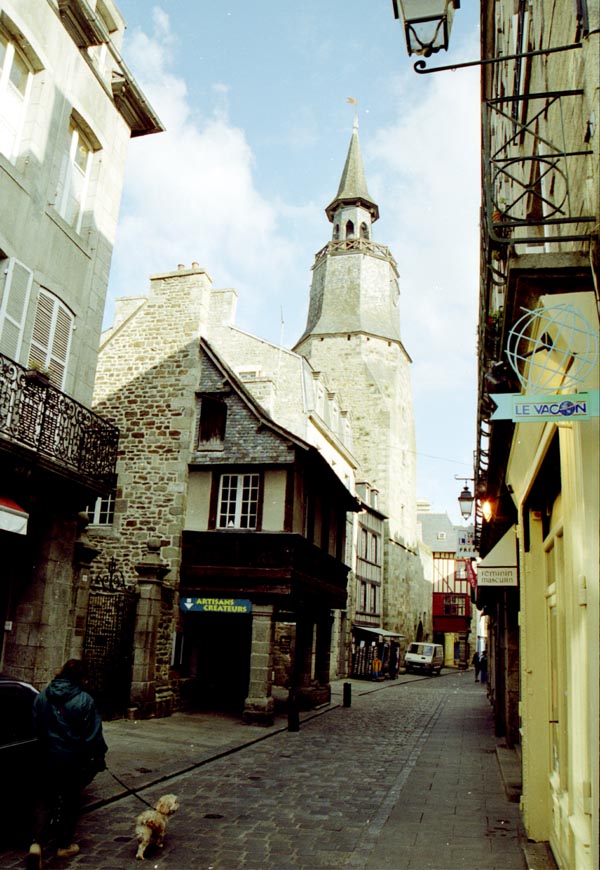
Monastery of the Franciscan Order (Couvent des Cordeliers, mid-13th century), monastery of the benedictine order (1638), now given to a college, and the former Dominican monastery located near the English Park - witnesses the most important episodes in the history of the city. The structure of the city is inherited from the Middle Ages, it is an interlacing of shopping streets with closely spaced houses, a mixture of alleys and small squares, where the echo of everyday life of the 15th century can still be heard. Worth visiting squares of Haberdashers (Place des Merciers), Cordeliers and Savior (Place Saint-Sauveur).
According to the tradition that emerged in 1983, every two years it hosts fete of the walls (Fete des Repmarts) , one of the most famous medieval festivals in Europe. During the holiday, which lasts for two days, the townspeople hold a knightly tournament, in connection with which the city is flooded with men in armor and with spears and ladies, strictly following the medieval fashion. The holiday ends with a costume parade, in which both the townspeople and the invited actors participate.
Dinan Port is at the base viaduct connecting the banks of the Rance River.
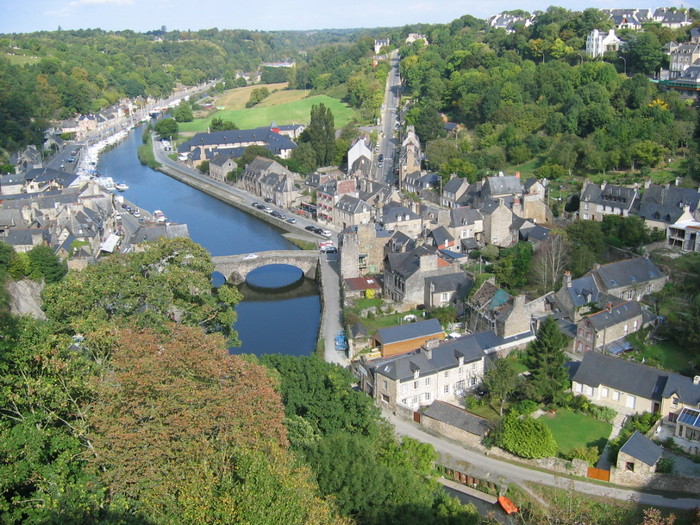
On the way, I propose to briefly stop at the feudal Fort-la-Latte castle and fort
... This fortified bridgehead, which protected the entrance to the bay, was equipped in the 13th century, rebuilt in accordance with the development military equipment in the 17th century.

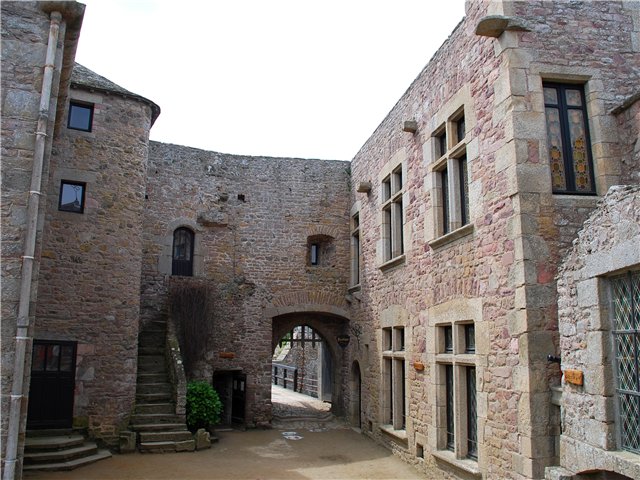
![]()
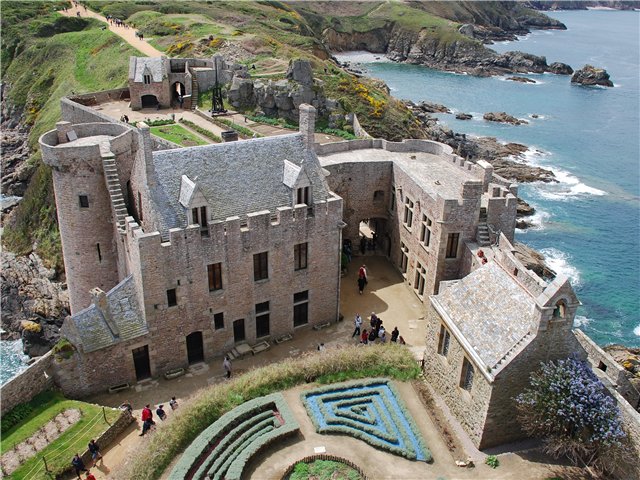
Let's make another stop in the town Treguier ... It is worth coming here to see a masterpiece of religious architecture - Cathedral Saint-Tugdual , one of the most beautiful places of worship in Brittany.
Coast of Rose Granite - one of the most romantic places not only in the province of Brittany, but in the whole of northern France, a real natural phenomenon.
The nearest settlement to it is a village Ploumanac "h" where tourists can find many souvenir shops and restaurants, not far from the village there is a magnificent sandy beach. But they come here primarily to admire the stunning beauty of the nearby rocks. The so-called “customs officer's path” runs from the village along the coast. Literally from every point of this trail, a magnificent view opens up to the town of Perros-Guirec, located about 5 km away, and to the fantastically beautiful coastline, forming coves into the ocean, is the Pink Granite Coast.
This coast is a jumble of pink granite rocks, and each stone here is unique in its own way. Some stones even got their own names, for example: "Turtle" or "Napoleon's Tricorne". Indeed, one does not need to have too much imagination to guess animal figures or familiar objects in the granite boulders.
And over all this granite kingdom, there is a lighthouse, carefully restored after the war.
It is especially beautiful here at sunset, when the stones turn from pink to almost red, and the ocean waters are absolutely blue. Fantastic in its beauty, the picture leaves almost no one indifferent.
The next stop of our journey is Morlaix.

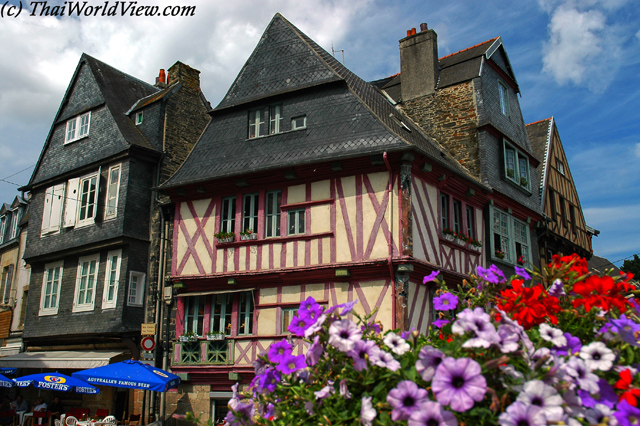
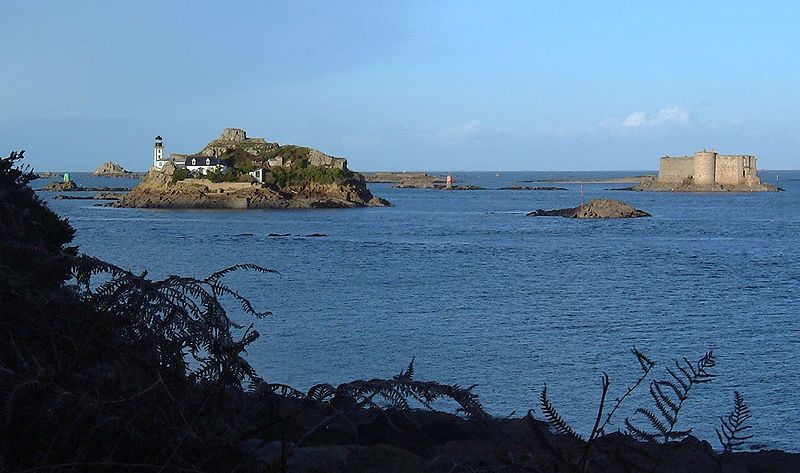
This town has a wonderful old aqueduct .
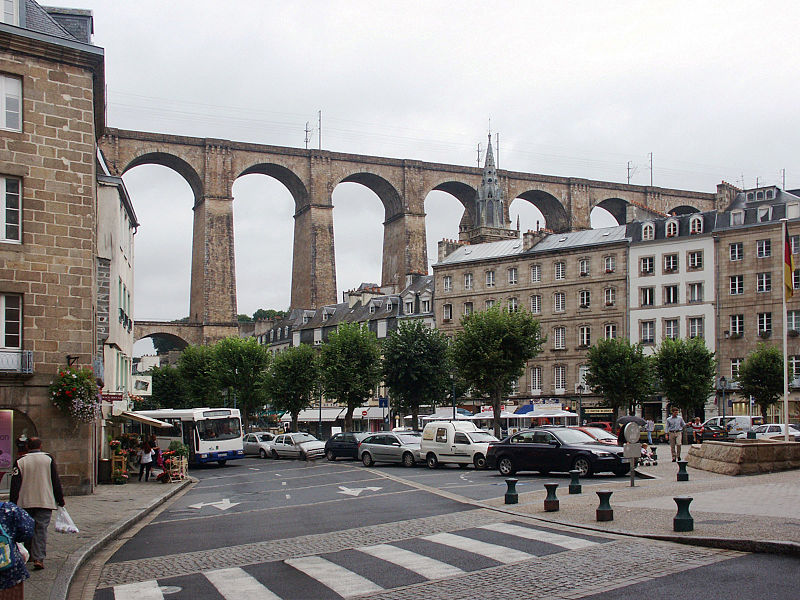
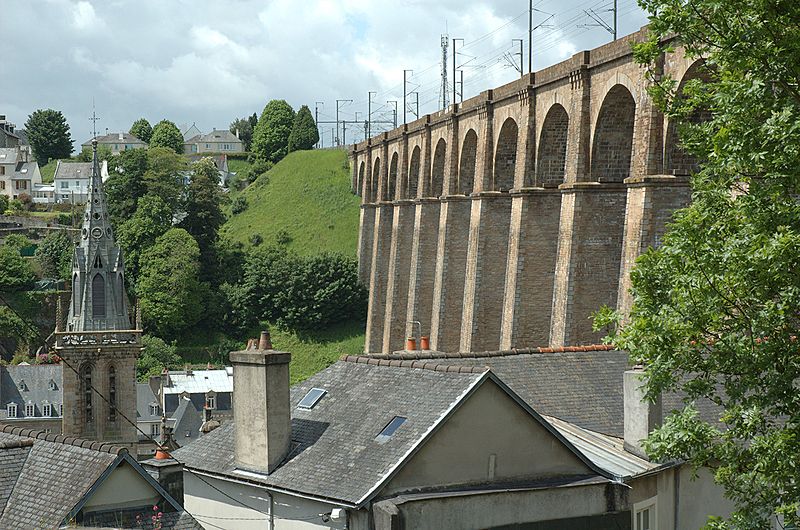
One of the local attractions are city sanctuaries of the XVI-XVII centuries called in French enclos paroissiaux ... This is a special complex of buildings, consisting of a cemetery, baptistery, baptismal and calver depicting scenes of the Passion and crucifixion of Christ, as well as the wall that separates the sanctuary from the city. Usually it is located near the city church.
The most beautiful sanctuaries in Brittany can be seen near Morlaix on the coast at Roskoff and Quimper. We will go there.
Initially Roscoff was a small fishing village. By the end of the 18th century. Roscoff became the second most important port, receiving major ferries from the islands of Great Britain, the bulk of the population was made up of peasants who successfully combine their activities with fishing and sea transportation. Many British tourists start their trip to Brittany with this. ancient city... The fact is that in the port of Roscoff there is one of the companies involved in organizing ferry tours between France and England. Roscoff is one of the most important trading ports for trade between mainland Europe and England.
Roscoff is famous not only for its unusually mild climate and delightful sandy beaches, but also for the variety of local architecture. It is a city with a rich historical past. It was here that in 1899 was founded the first wellness center, offering seawater treatments. The Roscoff Wellness Center has always used the latest technology.
Despite the fact that the town is small, there are several attractions that are worth seeing: aquarium, fish farm, and gothic cathedral of Our Lady in Kroa Bach (Kroas Batz) , the construction of which dates back to the 16th century. The city's attractions are also residential houses of builders of the 15th-17th centuries .
From Roscoff you can take a trip to island Bach (Batz) located near the town of Roscoff. The size of the island does not exceed - 3.5 km in length and 1.5 km in width. The island is ideal for walking.
Next, we go to Quimper, and on the way we will see a small medieval town Locronan - there, in the old square in the center of the city, there are many shops where you can see the works of local artisans from leather, cabinetmakers, full of local flavor - a wonderful souvenir from Brittany.
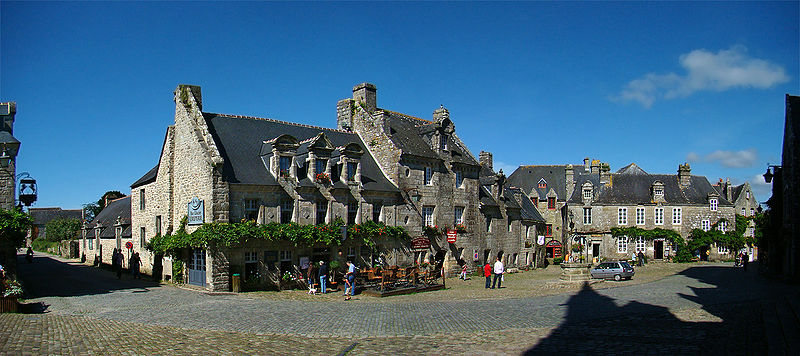
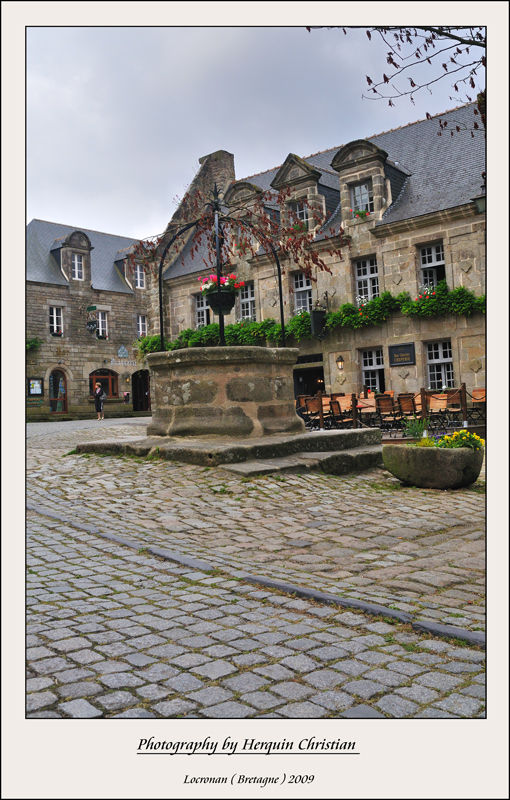
It is one of the most beautiful towns in Brittany. The secret of Locronan's appeal is very simple - not a single new building has been built here in the past few centuries! For a complete resemblance to the Middle Ages, all the wires in the city are laid underground. Naturally, there is not a single car here either (cars must be left at the entrance to the city). This is why Locronan has often been the setting for "historic" films, from Roman Polanski's Tess to Jean-Pierre Jeunet's The Long Engagement. Lokronan is a member of the Small Authentic Cities of Brittany and Most beautiful villages France ".
Located 20 minutes from Quimper, Locronan was named a city in 1505 by Anne of Breton, who was here on a pilgrimage. The name of the city means "Skete of St. Ronan", in honor of the Irish monk, who, according to legend, converted the locals to Christianity in the 5th century. In honor of Ronan is named and main temple city, Saint-Ronan. The heyday of Locronan, which began in the 15th century, was associated with the weaving skills of the townspeople. The fabrics of their hemp, which were produced by a local manufactory, were in demand not only in Brittany and France, but even in other countries! It was during this period that Lokronan emerged in the form in which he can be seen today.
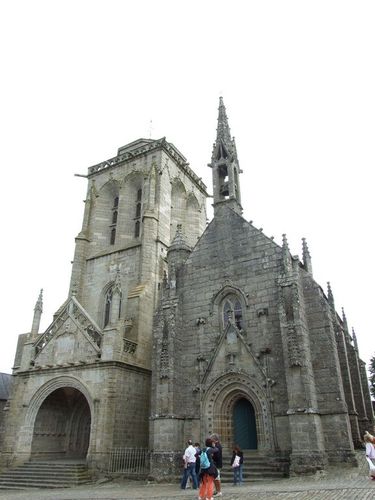

And so we come to Quimper
... It is a resort and art center. Quimper amazes with the beauty of its cathedrals and picturesque landscapes. The settlement at this place dates back to the 1st century. BC. Camper is conveniently located at the intersection of sea and land routes... Since the XIII century. the city was fortified, powerful stone structures were built. In 1960, the city expanded significantly due to the inclusion of three nearby suburbs. Walking around the city gives the impression of traveling in time.

Quimper - venue Cornish festivals. This is where you can see all the costumes and all the dances of the Cornish region! The highlight of the program is the local beauty pageant.
A special jury chooses the most beautiful girl in the most beautiful cap - the queen of the holiday. And the residents of Quimper and its environs themselves do not miss the opportunity to visit this festival. Most come in casual clothes (many simply do not have real Breton costumes), but those who are not averse to supporting the tradition dress the way their grandparents used to dress before the war.
The city is gothic Cathedral of Saint-Corentin with magnificent stained-glass windows of the 15th century. and an unusual arrangement of choirs, built in the XIII century.
St. Corentin's Cathedral is the oldest Gothic building in the region, construction of which began in 1240. In 1856, two spiers were added to the façade, between which stands a statue of King Gradlon, the mythical founder of the sunken city of Is. after the flood, he chose Kemper as new capital and Saint Corentin as a spiritual guide.
Interesting gate
leading to the courtyard, and in the cathedral itself, numerous stained glass windows aroused the greatest interest, including two of them by Paul Gauguin, who lived and worked in Brittany for 8 years.
Near the Cathedral of St. Corentin preserved part of the fortress wall , and around it there are wooden houses of the 17th century. The former main street with the oldest timber-framed houses in Quimper begins from the square.
Quimper is famous for the production of ceramics, which began at the end of the 17th century and is one of the main industries in the region today. Open for visiting museum of traditional faience and ceramic factory.
Museum of Fine Arts (Musee Des Beaux-Arts)
in Kemper includes more than 150 paintings, examples of local art of the XIX-XX centuries. Basically, the canvases reflect the people's daily life. The museum was founded in 1864 after, according to the will of Count Jean-Marie Sielget, most of his paintings and drawings were transferred to the city. The only requirement of the generous donor was that a museum be built to house this collection. The museum building was built in 1872 by the architect Joseph Hanje and the museum was opened. After the first renovation in 1976, the collection of the museum was expanded, new exhibition halls were added.
It is impossible not to visit Locmaria and Lanniron Castle , once the seat of the Camper bishops. It is also worth visiting Musee de la Crepe and Musee Oceanographique d'Odet .
The outskirts of the city are rich in medieval castles and manors.
Guilguiffin Castle (Chateau de Guilguiffin)
located in the southern part of Finistere, a few kilometers from Quimper. This luxurious castle, surrounded by a huge park, belongs to the category of historical monuments of the 18th century. You will enjoy walking in the park and discover a lot of interesting things. Once inside the walls of the castle, you will feel calm; you will be enchanted by the very special traditional atmosphere that reigns in this castle, which is located in the heart of an 18th century family estate.

In Pont L "Abba there is Biguden Museum (Bidouden) in a 14th century castle with a rich collection of local folk clothes as well as models of traditional Breton fishing boats. Address: Donjon du chateau 29120 PONT - L "ABBE.
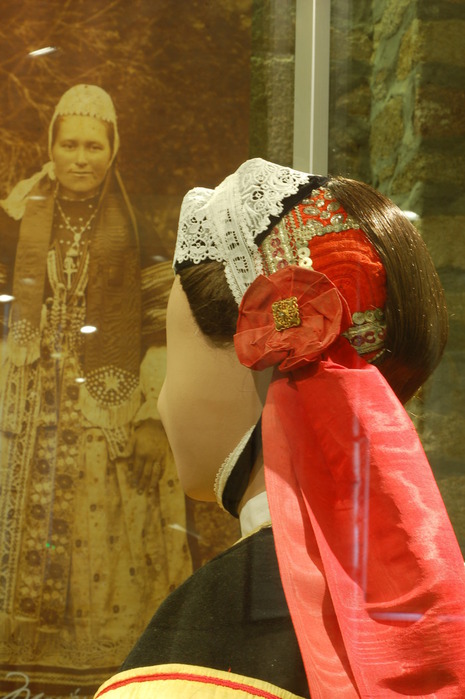
We drive further along the coast and find ourselves in Concarneau , surrounded by ancient granite walls of the city fortifications. On Fridays, traditional fish and local delicacies are traded along the coast, amid swaying brightly colored small and large boats. It is best to come here in the afternoon, when the trade has subsided a little and the crowds of tourists have already subsided - you will feel the charm of this small coastal town, you can take a picture in the "frame" of a traditional Breton costume, have a glass of wine in a coastal restaurant.
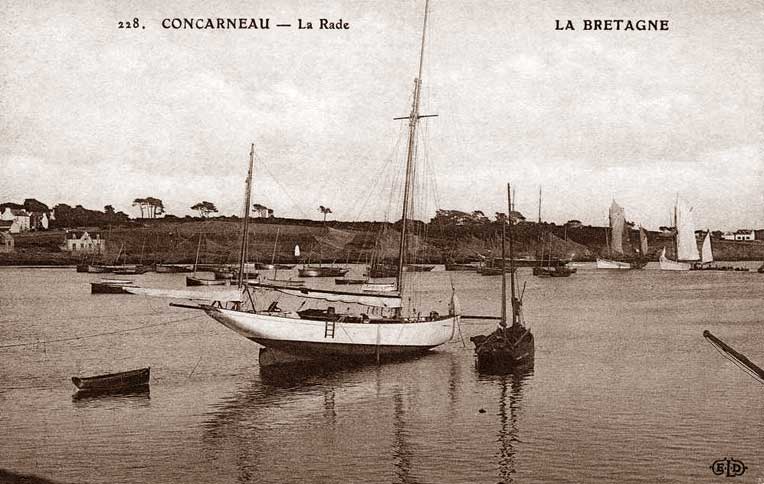
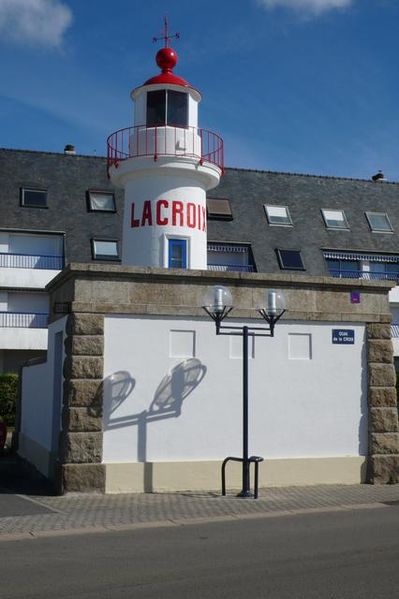
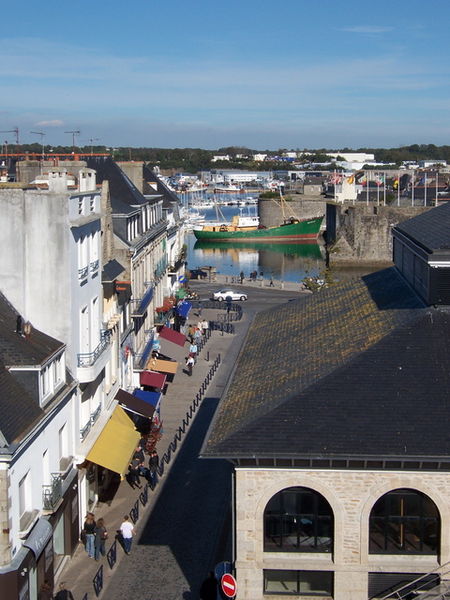
Concarneau consists of a modern harbor town on the coast of the sea and the old town of Ville-Clos on an elongated island in the center of the harbor, connected to the mainland by a bridge. All the main restaurants, souvenir shops and a fishing museum are concentrated in the old town.
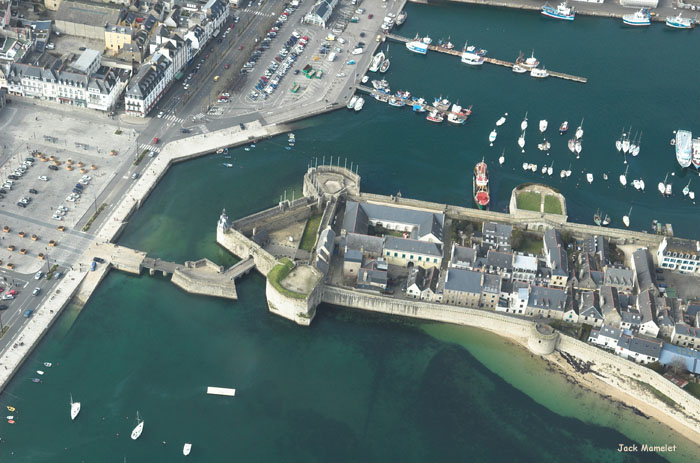
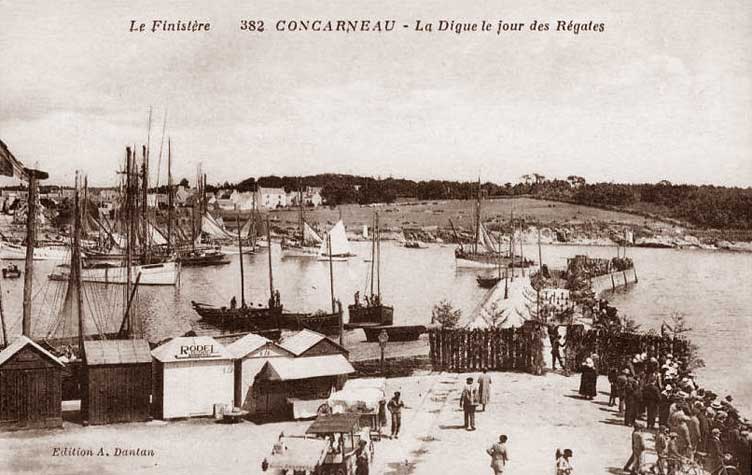
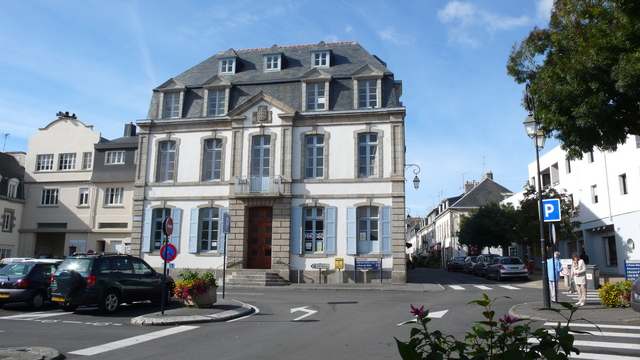
Every year since 1905, the city has hosted costume festival of blue nets (fr. Fete des Filets Bleus) dedicated to the traditional Breton fishing culture.
One of the most amazing sights in Brittany is menhirs (prehistoric structures made of large stone blocks) in the settlement Carnac ), of which there are about 3000. The name Karnak comes from the Breton "carn", literally "pile of stones".
Their appearance is attributed to the 6-3 millennium BC. BC, therefore very little is known about their meaning. They are conventionally called "Karnak stones". It is the largest cluster of megalithic structures in the world. They were erected by the pre-Celtic peoples of Brittany.


The megalith complex consists of several alleys:
- Le-Menec (Les alignements du Menec)
- 11 converging rows of menhirs stretched over a distance of 1165 meters, the width of the composition is 100 meters.
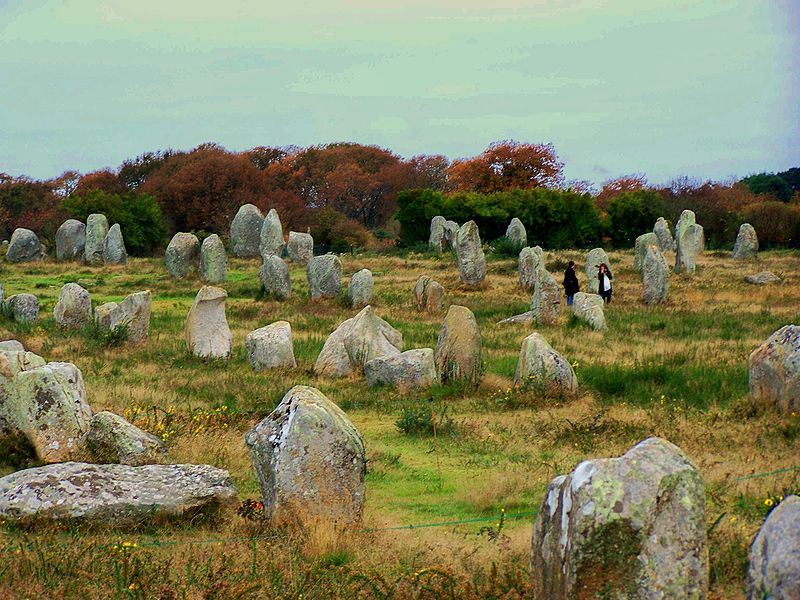
- Alley of menhirs Kermario (L'alignement de Kermario et le Manio) - consists of 1029 stones, arranged in 10 rows about 1300 meters long.
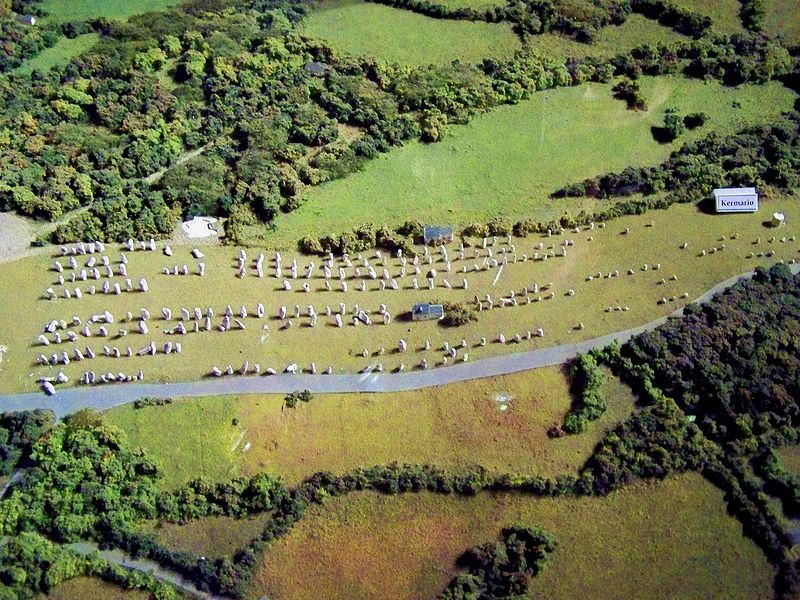
- Alley of menhirs Kerlescan - consists of 13 rows with a total length of about 800 meters, in the very west there is a stone ring of 39 stones.
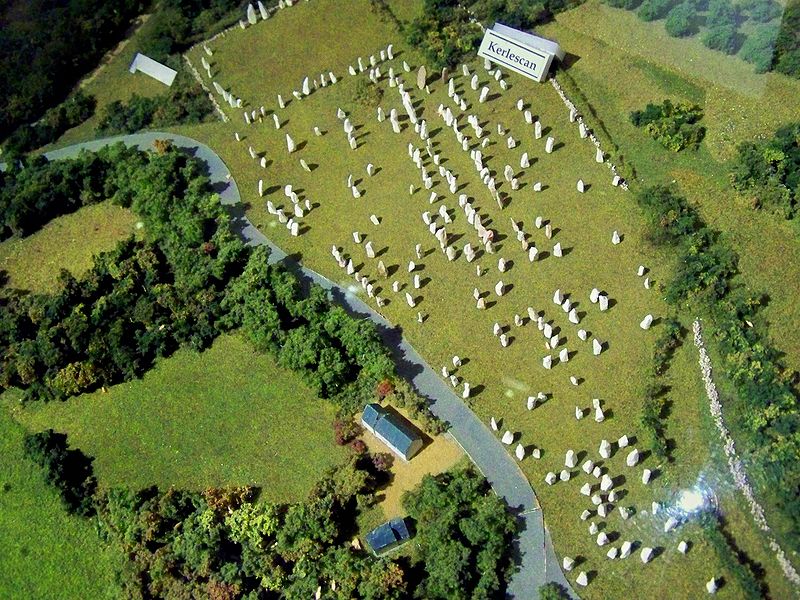
There are also several earthen mounds scattered over the graves. The mound usually has a passage leading to a central chamber, which once housed ancient treasures.

There are a number of dolmens
- ancient man-made structures of a certain shape made of large stones or stone slabs. They are considered to be ancient graves, and the absence of traces of bones in them is explained by the destructive effect of the acidic soil of Brittany. Dolmens are built of several large stones supporting one or more upper stones, often elongated and / or flat.

A little further on the coast is located Vannes ... It is a small town on the shores of the Gulf of Morbihan with a 2000-year history. It is a city of rich traditions. Vannes is one of the cities recognized by the Ministry of Culture as “cities of arts and history”. The city regularly organizes medieval festivals, light and musical performances and provides special lighting architectural monuments and also hold traditional Breton culture festivals or art contests.
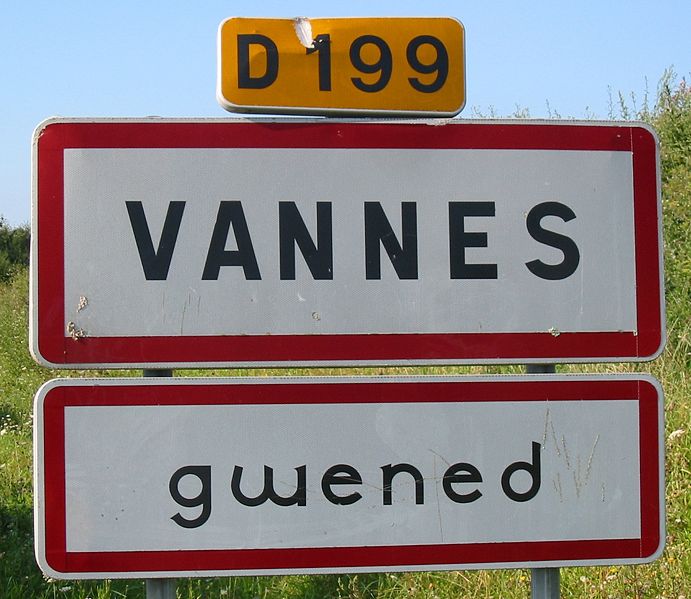
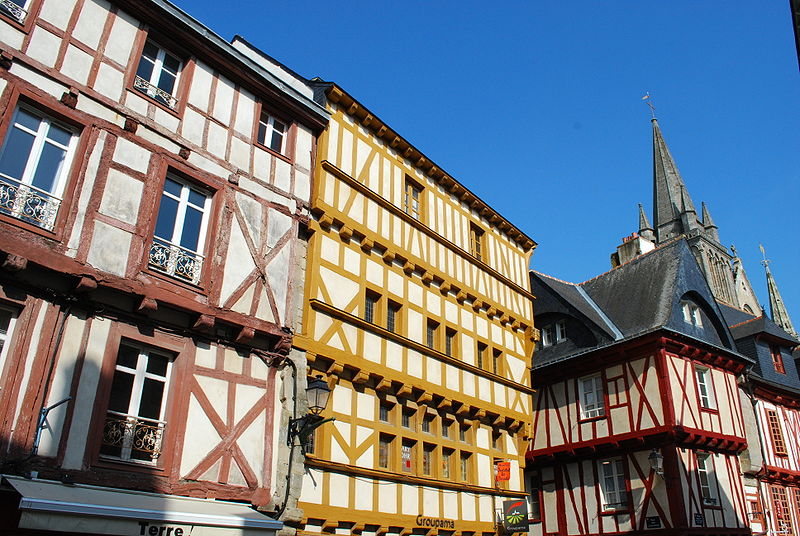

Inspection can begin from the port, from the majestic gate of Saint-Vincent (Porte Saint-Vincent) along the city wall to the Porte Prison. This is a real walk through the ages. The entire history of military architecture will unfold before you: from areas preserved from the Gallo-Roman era to the entrance towers of the 14th-15th centuries. At the foot of the powerful walls, on the site of former orchards, a classic French park is laid out along the Marla River.
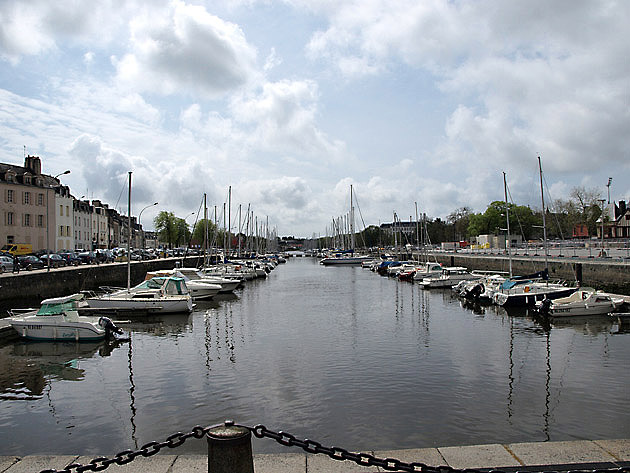
Within the city, half-timbered buildings of the 15th-16th centuries have survived. One of them - on the corner of rue Noe - is decorated with a pretty stone sculpture "Lieutenant Wang with his woman" - the symbol of the city. The origin of the sculptures is not known, perhaps it was a commercial sign for a pub.
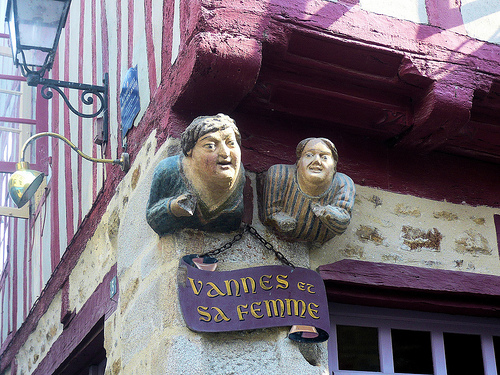
Like most ancient cities, the "old city" is protected by fortress walls. The ramparts have survived to this day, from which a beautiful view of the city opens. In the center of the "old town" there is a cathedral built in the 13th century.
Among the many attractions of the old city, a special place is occupied by old laundry (Lavoir) by the moat. The 17th century laundry house with steps leading to the river is one of the oldest surviving buildings in Brittany. The construction does not in any way fall out of the ensemble of the city, but, on the contrary, emphasizes its medieval features.
Another attraction of the "old city" is Archaeological Museum of Morbihan (Musee De La Prehistoire) ... Here are exhibits from the early settlements in Brittany, as well as archaeological finds from the megalithic era, found in the territory of Karnak. The museum is located in castle Gaillard XV century. Château Gaillard was commissioned by Jean Malestroth, Bishop of Nantes, and later Duke and 5th Chancellor (1408-1442).
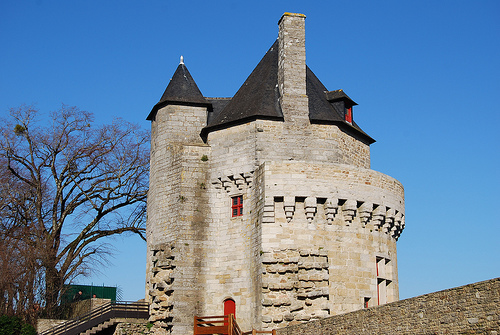
St. Peter's Basilica (Cathedrale Saint-Pierre) is one of the most significant sights of the city. The oldest fragments of the foundation of the temple date back to the 12th century, but the main part of the building is an example of flaming Gothic (16th century). Interior decoration the cathedral, the central nave and ten side chapels are typical enough.
The round Renaissance-style rotunda chapel dedicated to the Holy Gifts is especially remarkable. The walls are hidden by a magnificent tapestry from 1615 depicting the life of the saint.

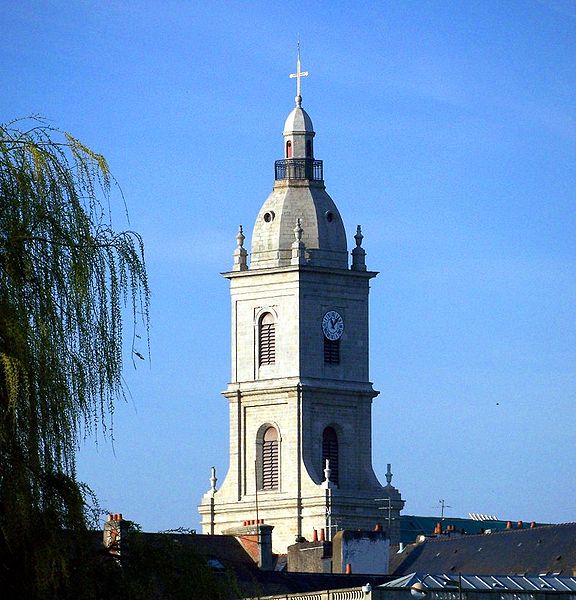
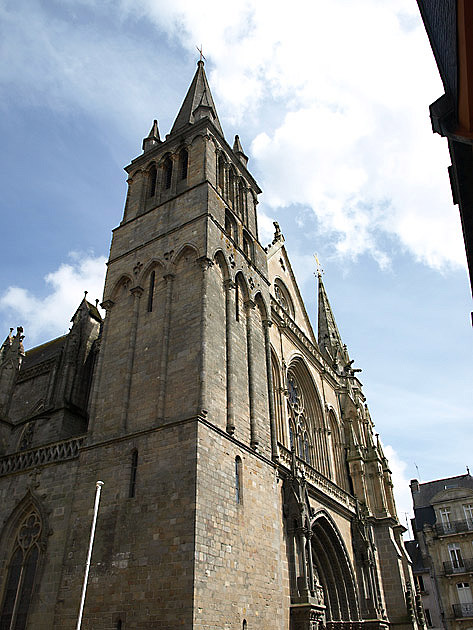
It will be very interesting to visit Palace of Automata (Palais Des Automates). This amazing museum will present to your attention many constantly moving dolls. You yourself will get the opportunity to revive the character you like. The museum has an exhibition area of 600 m2 on which several hundred different machines and structures are located. Address: Allee Loec Caradec 56000 Vannes.
Van history
Cited by
Liked: 1 user




